- Google News


Social Justice in Focus: A Comprehensive Guide to Principles and Practices
In a world of increasing interdependence and diversity, achieving social justice has become more important than ever.
In fact, it’s estimated that 45% of people in OECD-developed countries, including the United States, United Kingdom, Australia, and Canada, believe that their governments should be doing more to promote social justice (Diversity for Social Impact, 2023).
But what is social justice, and why does it matter in today’s society? Let’s delve into these questions.
Social justice is more than just a buzzword or an abstract ideal. It is a tangible, measurable concept that has significant implications for individuals, communities, and societies worldwide. It touches on every aspect of our lives, from the economy and politics to education and health.
It affects how we relate to each other, how we work, and how we live. Understanding social justice and striving for it is not just the right thing to do – it’s crucial for the health and sustainability of our global society.
Defining Social Justice
The scope of social justice, social justice in action, what is the role of individuals, organizations and governments in archiving social justice, the impact of social justice, challenges to achieving social justice, strategies and recommendations, social justice trends and predictions.
If we were to view society as an orchestra, social justice would be the harmonious sound produced when each instrument, or individual, is able to play their part without hindrance or disadvantage. In more concrete terms, social justice is the fair and equal distribution of resources and opportunities within a society. It is about ensuring that every individual, regardless of their race, gender, age, or socioeconomic status , is treated with dignity, has their rights respected, and is able to participate fully in society.
There are four key principles that underpin social justice: equality, fairness, rights, and participation.
Equality is about ensuring that everyone has an equal shot at success. This doesn’t mean making everyone the same, but rather, acknowledging and respecting differences and ensuring that these differences do not lead to discrimination or disadvantage.
Consider the different needs of individuals in a classroom: while one student might excel in a traditional learning environment, another might need additional support or alternative teaching methods. Equality is about recognizing and catering to these individual needs, ensuring that each student has the same opportunities to learn and succeed.

Fairness , on the other hand, relates to the distribution of resources and opportunities. This means that everyone should have access to the basic goods and services they need to live a decent life, regardless of their circumstances. Imagine a line of people of varying heights trying to watch a concert over a fence.
Giving each person the same size box to stand on may be equal, but it isn’t fair, as the shorter individuals still won’t be able to see. Fairness involves giving each person a box that is the right size for them, so they can all enjoy the concert equally.
The principle of rights involves recognizing and respecting the inherent rights of all individuals. This means treating everyone with dignity and respect, and ensuring that everyone has the right to live free from discrimination, abuse, and violence. It also means ensuring that everyone has the right to express their opinions, to associate freely with others, and to participate in public life.
Finally, participation is about ensuring that everyone has a voice and can participate in the decisions that affect them. This includes everything from voting in elections to participating in community meetings, or having a say in workplace policies. Participation is about more than just having a voice – it’s about having that voice heard and respected.
The concept of social justice has evolved over the centuries, shaped by social movements, philosophical ideas, and societal changes. Today, it is recognized as a key aspect of human rights and sustainable development. Despite the progress that has been made, however, there is still much work to be done.
Social justice isn’t confined to any one sector or area of life. It intersects with and permeates all parts of our society, including our educational system, healthcare institutions, workplaces, and environmental policies.
In the realm of education , for example, social justice entails equal access to quality learning for all students, regardless of their backgrounds. It’s about ensuring that children from low-income families have the same opportunities to succeed as their more affluent peers.
One instance is the Australian Gonski reforms, which in 2022 redistributed educational funding based on individual student needs, resulting in a significant improvement in the educational outcomes for disadvantaged students.
Healthcare is another sector where social justice plays a crucial role. It involves removing barriers that prevent people from accessing the care they need and promoting health equity.

In the UK, the National Health Service (NHS) stands as a testament to this principle. As a publicly funded healthcare system, it ensures that medical treatment is available to all, irrespective of their financial capabilities.
The world of work too, is greatly influenced by social justice principles. These principles guide the push for equal pay, workplace diversity, and against discrimination.
For instance, companies in the G7 countries have been making significant strides in closing the gender pay gap . The gender pay gap in Japan decreased by 1% in 2022 as a result of rigorous government policies and corporate commitment.
Finally, environmental justice , a component of social justice, focuses on the fair treatment and involvement of all people in environmental policies and practices, regardless of race, color, or income.
A striking example is the Paris Agreement, which recognizes the disproportionate impact of climate change on vulnerable countries and calls for a fair distribution of responsibilities and burdens.
To better grasp the impact of social justice, let’s explore some successful initiatives worldwide.
In Canada , the Truth and Reconciliation Commission stands as a powerful testament to social justice in action. Established in response to the horrific legacy of residential schools for Indigenous children, the Commission was instrumental in unveiling the truth about these schools, leading to public apologies, reparations, and policy changes to prevent such injustices in the future.
In New Zealand , the “Whānau Ora” (Family Health) policy is an innovative social justice approach to healthcare. This policy aims to empower New Zealand’s Indigenous Māori communities by focusing on community strengths and potential and providing culturally relevant care.
And in Singapore , the government’s robust public housing policy has played a vital role in fostering social justice by ensuring that every citizen has access to affordable, high-quality housing. This has contributed to Singapore’s low homelessness rate, high homeownership, and minimal residential segregation.

These are just a few examples among many. They demonstrate the transformative power of social justice when implemented effectively at the systemic level.
However, realizing social justice isn’t only the work of systems and institutions. As we will explore in the next sections, individuals, organizations, and governments each play a crucial role.
Achieving social justice is a complex and ongoing process, but as these examples show, it is both a feasible and profoundly impactful pursuit.
Promoting social justice is not solely the responsibility of a single entity. It requires concerted effort from individuals, organizations, and governments alike.
Individuals are the basic building blocks of any society, and they play a critical role in shaping social norms and attitudes. They can promote social justice in their daily lives through actions like calling out discrimination, educating themselves and others about social justice issues, and advocating for fair policies and practices.
For example, the widespread social media campaign #BlackLivesMatter in the USA , initiated by individuals, significantly influenced public discourse on racial justice and policy changes.
Organizations , including businesses and nonprofits, also play a critical role. Corporate Social Responsibility (CSR) initiatives, diversity and inclusion policies, fair labor practices, and philanthropy are ways they can contribute.
Professional Diversity Calendar Kit
The most direct and easy way to get quality cultural content for cultural competence education
GO: Diversity Calendar Kit
A case in point is Diversity for Social Impact’s 2023 report which showed that companies in the top quartile for gender or racial and ethnic diversity were more likely to have financial returns above their national industry medians by 36%.
Governments , as policy makers and enforcers, have a pivotal role to play. They can foster social justice by implementing laws and regulations that promote fairness, equality, and human rights. They can also institute social safety nets that protect the most vulnerable in society.
In the European Union, for example, comprehensive anti-discrimination laws have been enacted, and social security systems are in place to support individuals who are unemployed, ill, or elderly.
The benefits of a socially just society are multifold. It can lead to more inclusive economic growth, greater social cohesion, and improved health and wellbeing for all citizens.
A 2023 report by Diversity for Social Impact highlighted that OECD countries that scored higher on social justice indices had a higher GDP per capita by 27%. This correlation emphasizes the economic value of investing in social justice.
In addition, social justice can foster social cohesion by reducing societal divisions and tensions. For instance, in New Zealand, the government’s commitment to resolving historical injustices against the Māori people has played a critical role in promoting national unity and social stability.
Also, achieving social justice has a significant positive impact on individuals’ health and wellbeing.
According to a 2023 study published in The Lancet, countries with greater social justice had a life expectancy that was on average 6 years longer than countries with less social justice.
While the benefits are clear, the path to achieving social justice is fraught with challenges. It involves confronting entrenched societal barriers, addressing policy gaps, and countering resistance to change. In the next section, we will explore some of these challenges and ways they can be overcome.
Promoting social justice is not without its hurdles. There are significant societal and policy barriers that stand in the way, and resistance to change can often be a stumbling block.
Societal barriers , such as entrenched biases, stereotypes, and discriminatory attitudes, can hamper efforts to promote social justice. These barriers are often deeply ingrained, passed down through generations, and can pervade all aspects of life, from education and employment to healthcare and housing.
For example, despite clear laws against gender discrimination in the workplace, women in the G7 countries still earn on average 13% less than their male counterparts, according to a 2023 report by Diversity for Social Impact.
Policy barriers can also be an impediment to social justice. These can include a lack of laws protecting certain groups, insufficient enforcement of existing laws, or policies that unintentionally create or exacerbate inequalities.
In Hong Kong, for instance, a well-intentioned public housing policy inadvertently resulted in the segregation of ethnic minorities, until the government stepped in to amend the policy in 2023.
Lastly, resistance to change can be a significant challenge. Achieving social justice often requires changing the status quo, and this can be met with resistance from those who benefit from current arrangements or fear the uncertainty that comes with change.
Overcoming these challenges requires concerted and sustained efforts at all levels of society. It involves raising awareness, advocating for policy changes, and fostering a culture of inclusion and respect for diversity.
So, how can we promote social justice at different levels?
At the individual level , we can educate ourselves and others about social justice issues, call out discrimination when we see it, and use our voices and votes to advocate for fair policies. This could be as simple as having conversations with our friends and family about social justice, or as impactful as joining or starting a social justice campaign in our community.
At the organizational level , businesses can implement diversity and inclusion policies, promote fair labor practices, and engage in corporate social responsibility initiatives. Nonprofits can play a critical role in providing services , raising awareness, and advocating for policy changes.

At the government level , social justice can be promoted through laws and regulations that ensure equal rights and opportunities for all, social safety nets that protect the most vulnerable, and policies that foster social and economic inclusion.
In our journey towards social justice, we must remember that it is not a destination but a continuous process. It requires constant vigilance, advocacy, and action. But as we have seen, the benefits of a socially just society – greater economic prosperity, social cohesion, and wellbeing for all – make the journey worthwhile.
In the following section, we will address some of the common questions that arise in discussions about social justice and provide clear, straightforward answers to help deepen your understanding and clarify any misconceptions.
Frequently Asked Questions about Social Justice
What exactly is social justice, and why is it important?
Social justice is the concept of fair and just relations between individuals and society. It’s about ensuring equal distribution of wealth, opportunities, and privileges within a society. Social justice is important because it promotes a fair society where everyone, regardless of their background, has the opportunity to succeed and live with dignity.
Are there practical examples of social justice in action?
Yes, there are numerous examples of social justice in action. This includes policies aimed at reducing inequalities, like progressive taxation and affirmative action, social movements advocating for the rights of marginalized groups , and individual actions promoting fairness and equality.
What are some of the challenges in promoting social justice?
Promoting social justice can be challenging due to societal and policy barriers, as well as resistance to change. Overcoming these challenges often requires changing entrenched attitudes and behaviors, advocating for policy changes, and fostering a culture of inclusion and respect for diversity.
2. Does social justice only apply to certain groups of people?
No, social justice applies to everyone. It’s about promoting fairness and equality for all individuals, regardless of their race, gender, age, religion, or socioeconomic status. While certain groups may face specific social justice issues due to historical or systemic inequalities, the principles of social justice are universal.
3. Does promoting social justice mean giving everyone the same thing?
Not necessarily. Social justice is not about making everyone the same but ensuring everyone has an equal opportunity to succeed. This might mean providing different resources or support to different individuals based on their specific needs and circumstances.
4. Can individuals make a difference, or is it only the role of governments and organizations?
While governments and organizations play a crucial role, individuals can also make a significant difference. Individuals can promote social justice in their daily lives through actions like calling out discrimination, educating themselves and others about social justice issues, and advocating for fair policies and practices.
Social Justice and Business
In the modern era, corporations are increasingly recognized as important actors in the pursuit of social justice. As such, they have both the power and responsibility to promote social justice in their operations, from fair labor practices and diversity initiatives to philanthropic efforts and responsible sourcing.
In the USA, for example, the Business Roundtable, a group of CEOs from leading American companies, issued a statement in 2022 redefining the purpose of a corporation to include delivering value to customers, investing in employees, and supporting communities, not just maximizing shareholder value.
Moreover, data from a 2023 report by Diversity for Social Impact indicates that companies that prioritized diversity and inclusion saw an increase in their financial returns by 36%, reinforcing the business case for social justice.
However, the path towards corporate social justice is not without its challenges. Companies can face resistance from shareholders who prioritize short-term profits, struggle with embedding social justice into complex global supply chains, or grapple with how to effectively measure and report on their social impact.
To overcome these hurdles, businesses can adopt several strategies. They can engage stakeholders in meaningful dialogue about social justice, integrate social justice into their strategic planning, invest in robust systems to track their progress, and be transparent about their successes and failures.
As we look towards the future, several trends are likely to shape the landscape of social justice.
First, the COVID-19 pandemic has underscored the deep inequalities in our societies, from healthcare to the digital divide, and sparked a global conversation about social justice. This increased awareness is likely to translate into a stronger push for social justice in the coming years.
Second, younger generations, particularly Millennials and Generation Z, are showing a deep commitment to social justice. They are likely to carry this passion into their roles as future leaders, consumers, and citizens, influencing everything from corporate practices to government policies.
Third, technological advancements are opening up new possibilities for promoting social justice. From AI that can help reduce bias in hiring, to social media platforms that amplify marginalized voices, technology can be a powerful tool for social justice.
However, this is not to ignore the potential challenges. As the world becomes increasingly interconnected, the issues become more complex, requiring nuanced, multi-faceted solutions that take into account the global nature of many social justice issues.
Yet, one thing is clear: Social justice will continue to be a vital goal for societies worldwide. It is not a trend that will fade away, but a constant pursuit that requires our ongoing commitment and action. As we continue on this journey, let us draw on our collective strengths and shared humanity to build a more just and equitable world.
Social Justice in depth
Business Roundtable. (2022). Statement on the Purpose of a Corporation. Retrieved from https://www.businessroundtable.org
Diversity for Social Impact. (2023). Corporate Diversity and Inclusion Report. Retrieved from https://diversity.social
European Union. (2022). Anti-Discrimination Laws and Regulations. Retrieved from https://europa.eu
Government of New Zealand. (2023). Policies on Maori Rights and Reconciliation. Retrieved from https://govt.nz
Government of Hong Kong. (2023). Public Housing Policies and Amendments. Retrieved from https://gov.hk
You may also like

Brand Ambassador: The Complete Guide

Unconscious Bias – Definition & Examples in a Diverse Workplace
What is Unconscious Bias? How will bias impact us in the...

Don’t forget to celebrate Diversity & Inclusion
Black History Month, LGBT+ History Month

Think Valentine’s Day Is Tough Now? The Holiday Used to Involve Choosing a Sweetheart by Lottery
Here's How Valentine's Day Is Celebrated Around the World

Social Sustainability – Everything You need to know
What is social Sustainability? social sustainability...

Glass Ceiling Definition: How to break it anywhere?
What is "the glass ceiling" or the Glass Ceiling Effect?
About the author
Naia has over 15 years of experience advising Fortune 1000 employers in Diversity and Inclusion. Naia holds a Master's degree in Human Resource Management with a research focus in workplace equality.
Join 34,000+ subscribers and Sign up to our Newsletter
- Curriculum and Instruction Master's
- Reading Masters
- Reading Certificate
- TESOL Master's
- TESOL Certificate
- Educational Administration Master’s
- Educational Administration Certificate
- Autism Master's
- Autism Certificate
- Leadership in Special and Inclusive Education Certificate
- High Incidence Disabilities Master's
- Secondary Special Education and Transition Master's
- Secondary Special Education and Transition Certificate
- Virtual Learning Resources
- Frequently Asked Questions
- Video Gallery
- Financial Aid
15 Ways to Advance Social Justice in your Community

There are moments in world history when social justice issues come to the forefront of global consciousness. This is such a time. The coronavirus pandemic has uncovered and exacerbated social inequities, especially in the United States. 1 Closely related, due to its social justice component, is the expansion of Black Lives Matter into a worldwide movement. The protest sparked by the killing of George Floyd and police brutality 2 grew into demonstrations against larger issues of racial inequality and systemic racism. Social justice plays a role in nearly every critical problem that we face, from the climate emergency 3 and voter suppression 4 to gun violence 5 and the widening income gap.
Society’s collective lens is now sharply focused on the disparity of experience among different social groups. People are energized regarding crucial issues—LGBTQ legal protections, abuse of women, the rights of immigrants and indigenous peoples, racial discrimination and more. Today’s educators have a unique opportunity to advocate for their students and communities, and to demand substantive change.
Here are 15 ways that you can advance social justice, individually and through alignment with like-minded people in your community and throughout the world.
Examine your beliefs and habits.
Educate yourself about social justice issues., discover your local organizations., take positive action in your own community., harness the power of social media., attend demonstrations and protests..
- Idealist - Browse by area of focus, language, and time availability.
- GozAround - Search by category and find matches for your abilities and schedule.
- VolunteerMatch - Search for local and virtual volunteer work by topic and by organization names.
Get involved with politics through civic engagement.
Make your voice heard on local radio, investigate what’s happening at local colleges or universities., invest responsibly., support minority-owned businesses in your community and online., support artists, writers, and activists who speak out against injustices., be kind, understanding, and compassionate., prepare to meet today’s demands at the university of kansas..
1. Retrieved on July 1, 2020 from abcnews.go.com/Business/extreme-inequality-preexisting-condition-covid-19-widened-americas/story? 2. Retrieved on July 1, 2020 from aljazeera.com/news/2020/06/timeline-george-floyd-protests-200610194807385.html 3. Retrieved on July 1, 2020 from ecowatch.com/environment-social-justice-2646167147.html?rebelltitem=1#rebelltitem1 4. Retrieved on July 1, 2020 from brennancenter.org/issues/ensure-every-american-can-vote/vote-suppression 5. Retrieved on July 1, 2020 from amnesty.org/en/what-we-do/arms-control/gun-violence/ 6. Retrieved on July 1, 2020 from mashable.com/2014/12/10/volunteer-work-online/ 7. Retrieved on July 1, 2020 from money.usnews.com/investing/slideshows/7-of-the-best-socially-responsible-funds 8. Retrieved on July 1, 2020 from refinery29.com/en-us/2020/06/9849096/find-black-owned-businesses-online-apps
Return to Blog
IMPORTANT DATES
Stay connected.
Link to twitter Link to facebook Link to youtube Link to instagram
The University of Kansas has engaged Everspring , a leading provider of education and technology services, to support select aspects of program delivery.
The University of Kansas prohibits discrimination on the basis of race, color, ethnicity, religion, sex, national origin, age, ancestry, disability, status as a veteran, sexual orientation, marital status, parental status, retaliation, gender identity, gender expression and genetic information in the University's programs and activities. The following person has been designated to handle inquiries regarding the non-discrimination policies and is the University's Title IX Coordinator: the Executive Director of the Office of Institutional Opportunity and Access, [email protected] , 1246 W. Campus Road, Room 153A, Lawrence, KS, 66045, (785) 864-6414 , 711 TTY.
University of Evansville
Academic programs social justice, journey to justice.
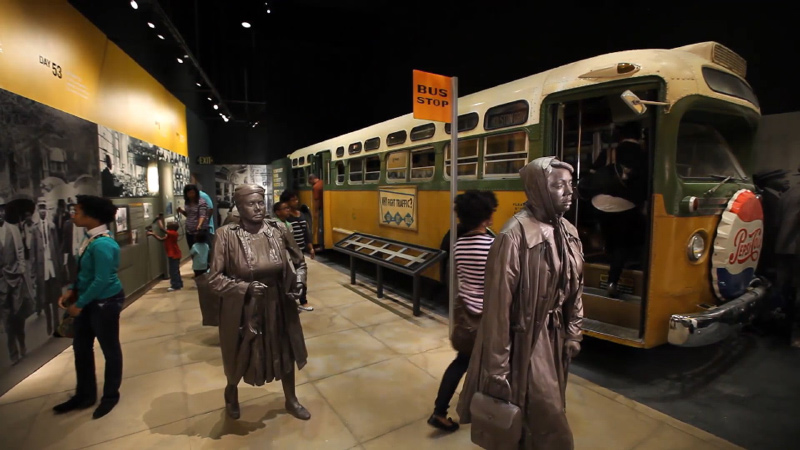
Civil Rights Bus Tour
Join us on a journey of transformation as we travel the path of civil rights activists to explore questions of truth, meaning, and value that will drive us to create a more just and equitable world.
High school students can earn college credit for the ESC major through Journey to Justice a summer program that centers on an 8-day bus trip through cities of the South to explore the history of the Civil Rights Movement.
Social Justice majors may also opt to fulfill the ETH 200 Social Justice Movements requirement with the Journey to Justice Civil Rights bus tour.
Office Phone 812-488-1103
Office Email [email protected]
Office Location Room 341, Olmsted Administration Hall
You’re about to leave the University of Evansville Website to visit a third-party partner site.


From Marginalization to Empowerment: The Journey of Social Justice
The journey of social justice.
Social justice is the idea that every individual deserves equal rights and opportunities, regardless of their background or identity. However, the journey towards achieving social justice has been long and challenging, with marginalized communities facing discrimination and exclusion for centuries. In this article, we will explore the journey of social justice and how marginalized communities have moved towards empowerment.
Table of Contents
Marginalization of Communities
Marginalization refers to the process of being pushed to the margins or periphery of society. It is a process of exclusion where certain communities are denied access to resources, opportunities, and basic rights. Marginalized communities can be defined by factors such as race, ethnicity, gender, sexual orientation, religion, disability, or socioeconomic status.
One of the most significant examples of marginalization is the treatment of African Americans in the United States. For centuries, African Americans were denied basic human rights and treated as inferior to white Americans. This discrimination was enshrined in law, with the Jim Crow laws enforcing racial segregation and denying African Americans access to education, housing, and employment opportunities.
Marginalization can also be seen in the treatment of women in many societies. Women have been denied access to education, employment opportunities, and basic rights such as the right to vote. They have also faced sexual harassment and assault, with many perpetrators going unpunished.
The journey of social justice has been a long one, with marginalized communities fighting for their rights and empowerment. This fight has taken many forms, from civil rights movements to social media campaigns.
Civil Rights Movement in the United Stat es
The civil rights movement in the United States was a major turning point in the journey towards social justice. The movement, led by figures such as Martin Luther King Jr., aimed to end racial segregation and discrimination against African Americans. The movement used tactics such as protests, boycotts, and civil disobedience to raise awareness and pressure lawmakers to pass civil rights legislation.
The Civil Rights Act of 1964 was a major victory for the civil rights movement, outlawing discrimination based on race, color, religion, sex, or national origin. The act also ended racial segregation in schools, workplaces, and public places.
Women’s Rights Movement
The women’s rights movement has also been a significant force in the journey towards social justice. The movement, which began in the late 19th century, aimed to secure equal rights for women, including the right to vote and access to education and employment opportunities.
The movement achieved a major victory with the passage of the 19th Amendment to the US Constitution in 1920, which gave women the right to vote. The movement also led to changes in laws and policies, such as the Equal Pay Act of 1963, which aimed to end gender-based wage discrimination.
LGBTQ Rights Movement
The LGBTQ rights movement has also played a significant role in the journey towards social justice. The movement, which began in the 1960s, aimed to secure equal rights and protections for LGBTQ individuals, including the right to marry and protections against discrimination.
The movement achieved a major victory with the Supreme Court’s decision in Obergefell v. Hodges in 2015, which legalized same-sex marriage in all 50 states. The movement has also led to changes in laws and policies, such as the Employment Non-Discrimination Act, which aimed to protect LGBTQ individuals from employment discrimination.
Social Media Campaigns
Social media has also played a significant role in the journey towards social justice. Social media campaigns have raised awareness of issues such as police brutality, sexual harassment, and discrimination.
The #MeToo movement, which began in 2017, aimed to raise awareness of sexual harassment and assault, particularly in the workplace. The movement gained widespread attention on social media, with people sharing their stories of harassment and assault using the
hashtag #MeToo. The movement led to increased awareness of the issue and sparked a global conversation about sexual harassment and assault.
Similarly, the Black Lives Matter movement, which began in 2013, aimed to raise awareness of police brutality against Black individuals. The movement gained widespread attention in 2020 following the killing of George Floyd, which sparked protests and demonstrations around the world. The movement has led to increased awareness of police brutality and systemic racism, and has sparked conversations about how to address these issues.
Empowerment of Marginalized Communities
The journey towards social justice has not been easy, but marginalized communities have made significant progress towards empowerment. Empowerment refers to the process of gaining control over one’s life and making decisions that affect one’s life and community.
One example of empowerment is the rise of women in leadership roles. Women have made significant progress in breaking through the glass ceiling and occupying positions of power and influence. In 2021, Kamala Harris became the first female vice president of the United States, a significant milestone in the journey towards gender equality.
Similarly, the LGBTQ community has made significant progress towards empowerment. LGBTQ individuals are now able to marry and enjoy the same legal protections as heterosexual couples. LGBTQ individuals have also made significant progress in visibility and representation in the media and popular culture.
Table: Examples of Marginalized Communities and Their Empowerment
The journey towards social justice has been long and challenging, but marginalized communities have made significant progress towards empowerment. Civil rights movements, social media campaigns, and legal victories have all contributed to this progress. However, there is still much work to be done to ensure that every individual has equal rights and opportunities, regardless of their background or identity. By continuing to fight for social justice, we can create a more just and equitable society for all.

Christa Rose Avampato is a versatile author known for her captivating narratives and thought-provoking insights. With a passion for diverse genres, she weaves rich experiences into her writing, creating vivid characters and compelling storylines.
Share this post
How do we journey from injustice to justice?
What would an ‘abolitionist’ society look like? What new practices, policies and institutions need to be created to realize both safety and justice?
What is the relationship of capitalist extraction to the climate crisis?
What can we learn from cooperatives and solidarity economies?
The Social Justice Portal Project is a movement-centered collaborative think tank mobilizing scholars and activists to share, debate and map visions for transformative change.
Portal Participants
Marielle franco and margaret burroughs fellows.

Jamila Woods
Singer, Songwriter and Poet
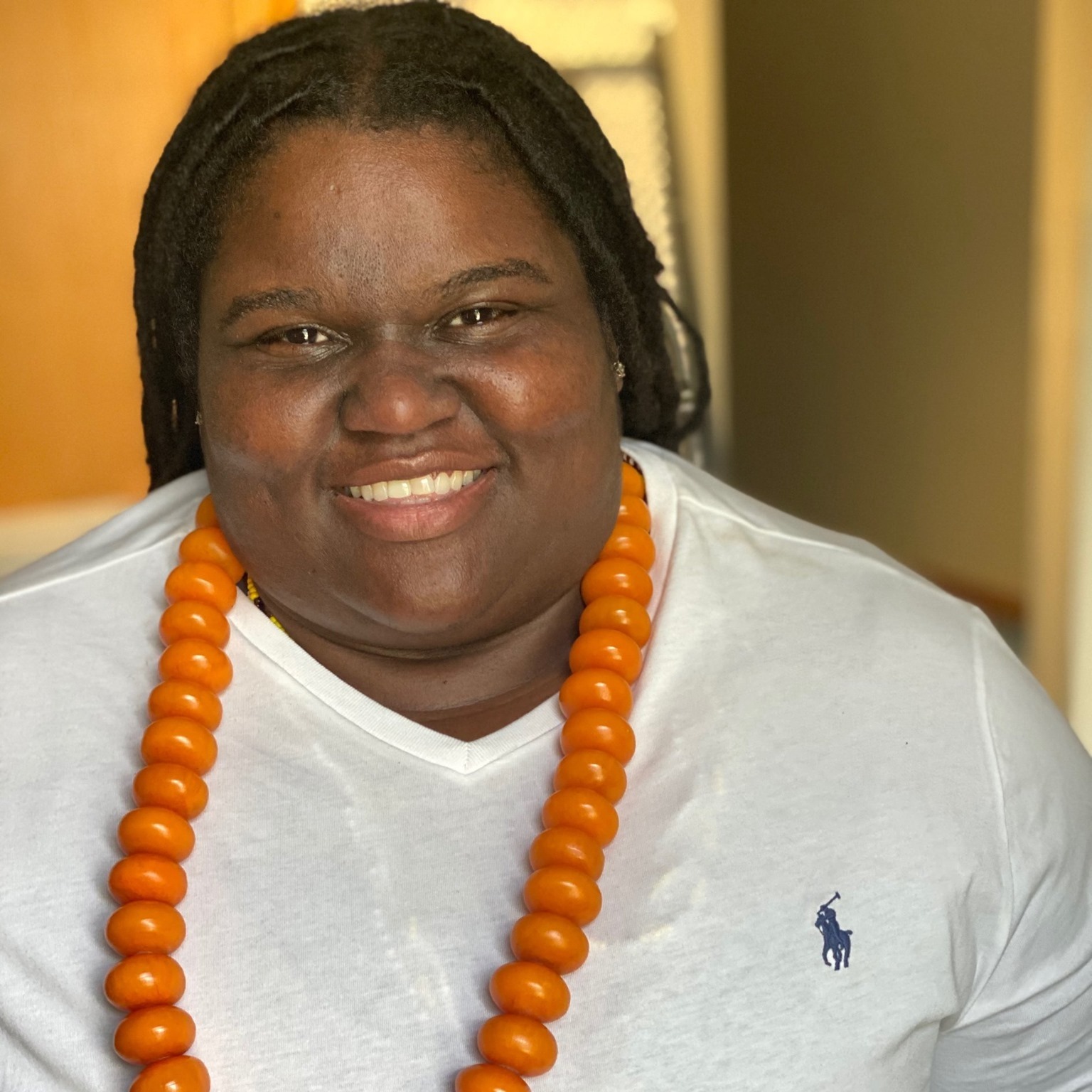
Community Organizer, Co-Executive Director at the Movement for Black Lives

Damon Williams
Co-Director of #LetUsBreathe Collective
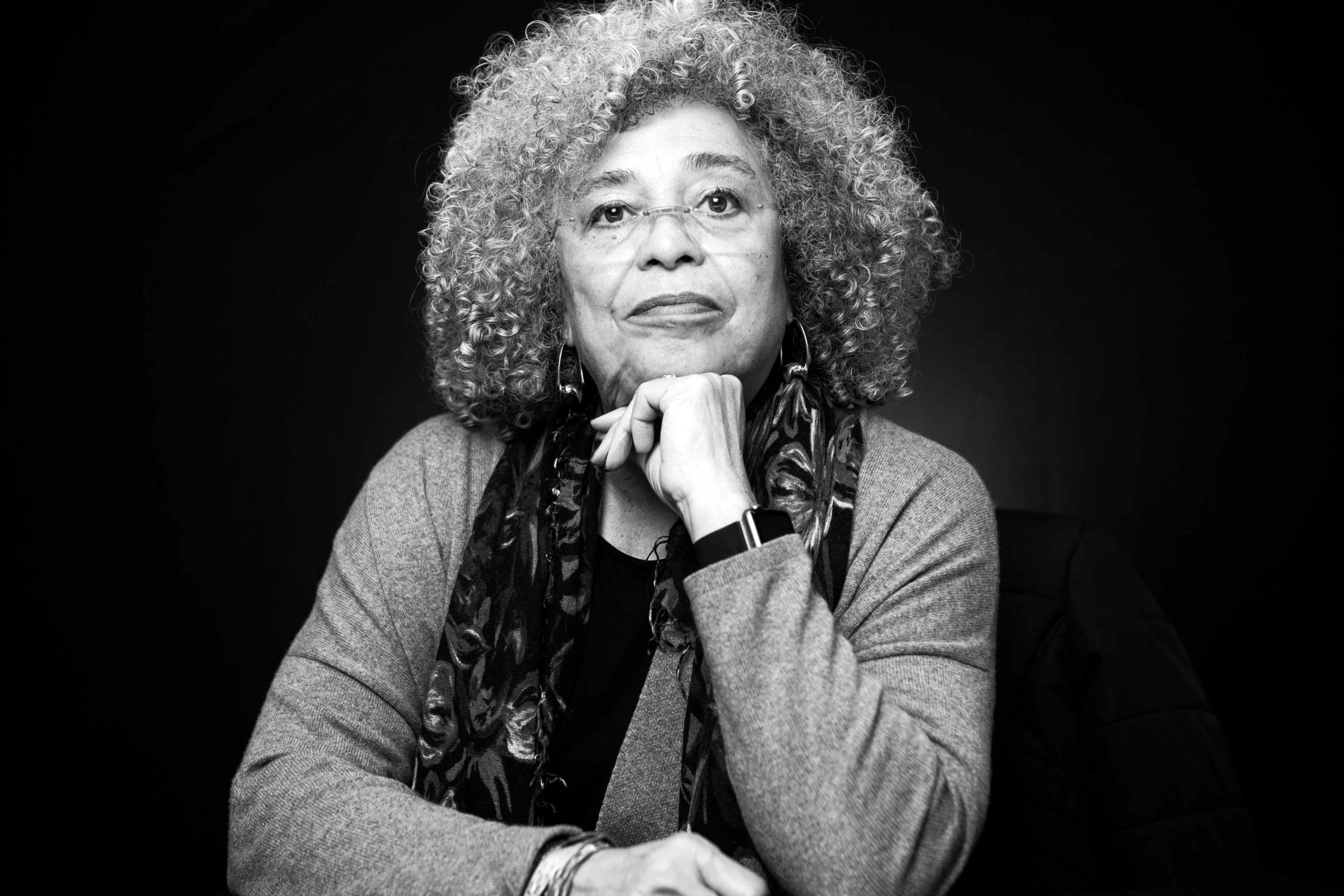
Angela Y. Davis
Scholar, Author, Organizer
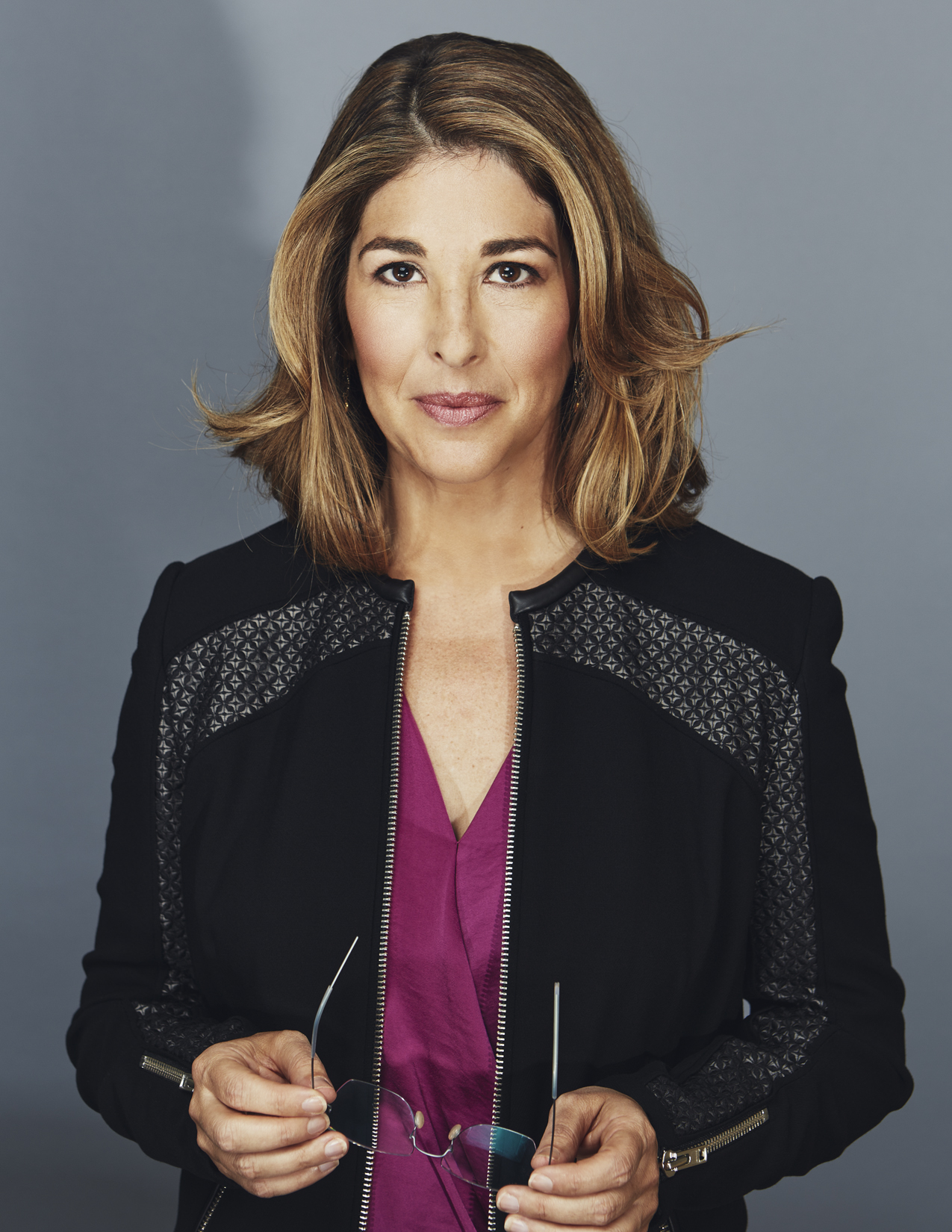
Naomi Klein
Journalist, Climate Justice Scholar, Author
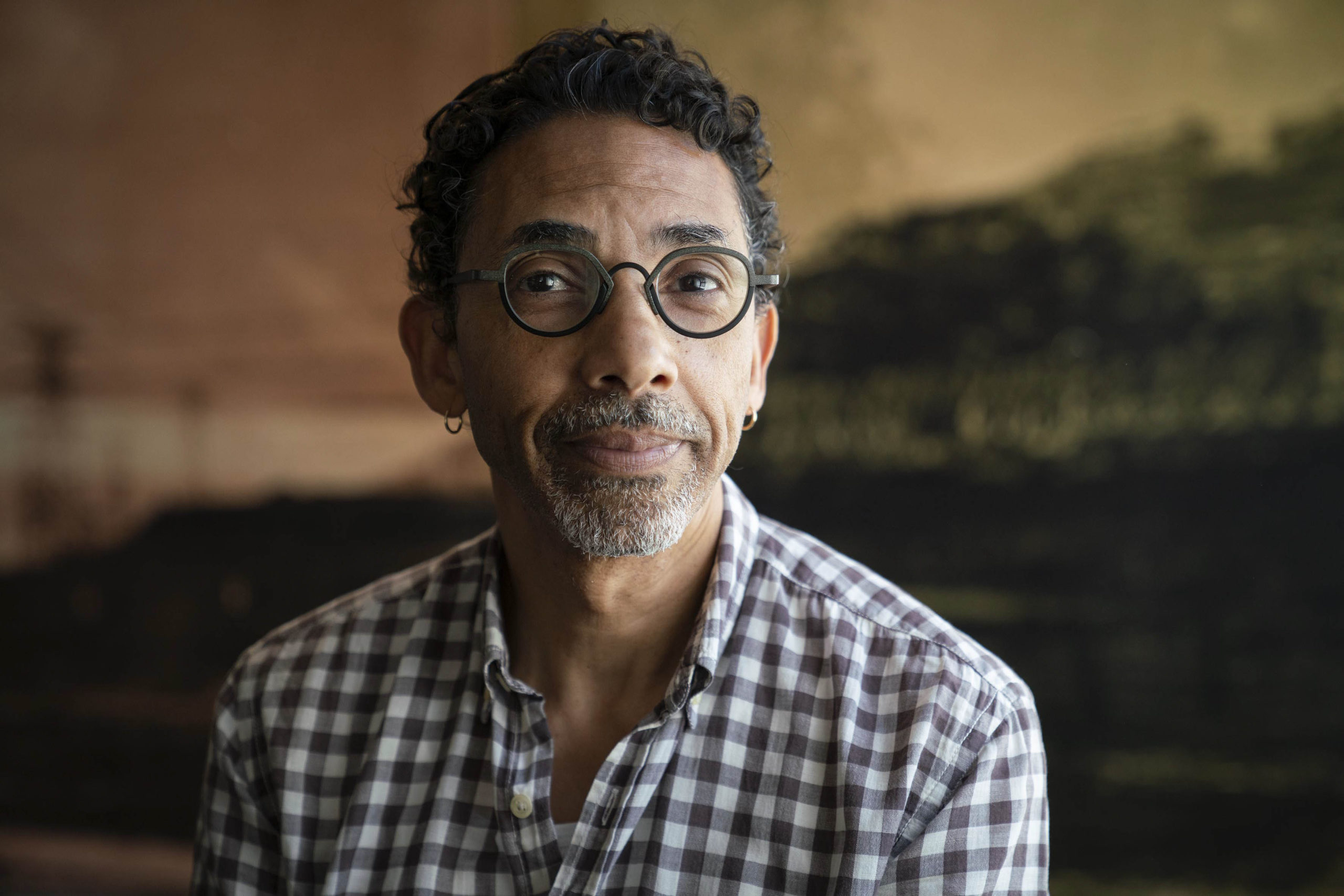
Robin D. G. Kelley
Historian, Scholar, Author
How do we link movement, theory, history and practice in the service of creating a better world?
Portal Project Events
view all
Learn about the research, histories and work within our three main Portal Project entry points: abolition, economic democracy and climate justice.
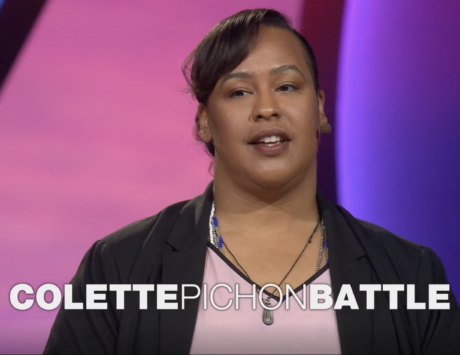
Climate Justice
Climate Change Will Displace Millions. Here’s How We Prepare by Colette Pichon Battle
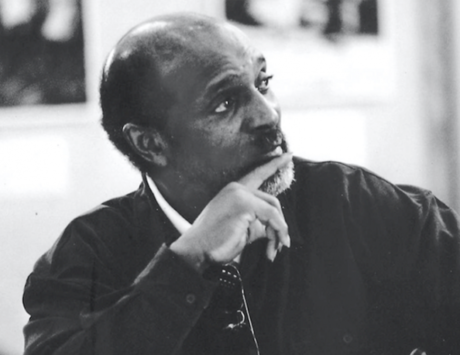
Economic Democracy
What Did Cedric Robinson Mean by Racial Capitalism? by Robin D. G. Kelley
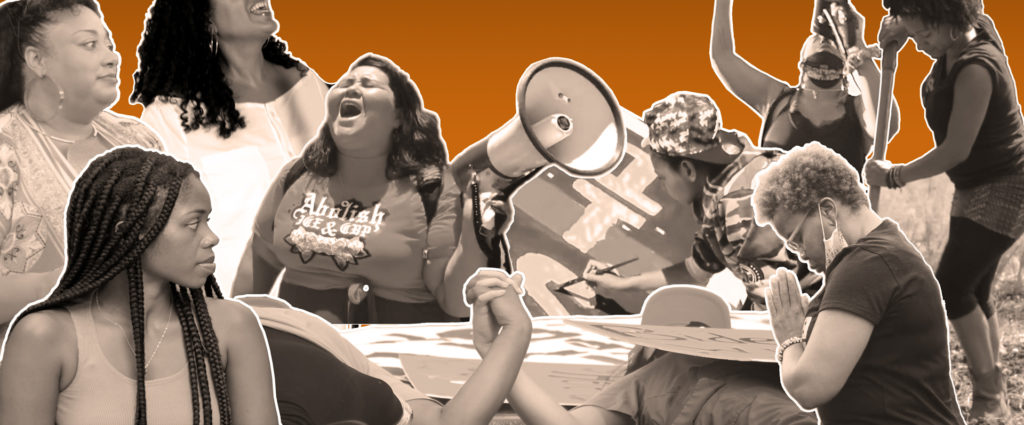
Social Justice Portal Project Releases Documentary Short and New Song on Abolition
More About Portal Project
Stay Connected
Mapping visions for transformative change.
" * " indicates required fields
Social justice, racial equity, and the path forward
January 17, 2022 Martin Luther King Jr. grappled with many national issues during his lifetime, including unemployment, workers’ rights, protests, poverty, and segregation. As we look back on both his many accomplishments and profound challenges, it remains clear there’s still much work to do in the movement toward racial equality. On this day honoring the civil rights leader’s impact and legacy, explore these insights on what can be done to build a more just future, and visit the McKinsey Institute for Black Economic Mobility for the latest research on how to empower, inspire, and sustain action that leads to the economic development of Black communities across the globe.
The economic state of Black America: What is and what could be
Race in the workplace: The Black experience in the US private sector
Black consumers: Where to invest for equity (a preview)
The Black unicorn: Changing the game for inclusivity in retail
Black-owned businesses face an unequal path to recovery
A $300 billion opportunity: Serving the emerging Black American consumer
Black representation in film and TV: The challenges and impact of increasing diversity
Our future lives and livelihoods: Sustainable and inclusive and growing
The economic impact of closing the racial wealth gap
More from Author Talks
Ella Bell Smith on why race and class are wedges between women
Dorothy A. Brown on the whiteness of wealth
Michelle Duster on the legacy of Ida B. Wells
Mia Bay on traveling Black
The history of Black cinema in America

What Does Social Justice Mean?
Justice is the concept of fairness. Social justice is fairness as it manifests in society. That includes fairness in healthcare, employment, housing, and more. In a socially-just society, human rights are respected and discrimination is not allowed to flourish. What’s the origin of the phrase “social justice?” It was most likely first used in the 1780s and appears in Paper #7 of The Federalist Papers . As the Industrial Revolution wound down, American legal scholars applied the term to economics. Today, its use has expanded significantly and applies to all parts of society. It’s seen through the lens of traits like race, class, sexuality, and gender. What does social justice look like?
Take a free course on Social Justice by top universities and NGOs
The principles of social justice
For social justice to become a reality, four pillars must be built: human rights, access, participation, and equity. Social justice can’t be achieved without these four principles.
Human rights
The connection between social justice and human rights has strengthened over the years to the point where many use “social justice” and “human rights” interchangeably. While they are technically different, it’s clear to activists that one can’t thrive without the other. When a society is just, it protects and respects everyone’s human rights. When a society respects and promotes human rights, social justice flourishes. This connection is essential because human rights are recognized globally. When activists fight for social justice, they can lean on the connection with human rights to hold governments, corporations, and individuals accountable.
A just society depends on access to essentials like shelter, food, medical care, and education. It isn’t enough for a society to invest in innovations or create new opportunities; society must also prioritize access. If access is restricted based on factors like gender, race, or class, it leads to suffering for individuals, communities, and society as a whole. Social justice activists spend a lot of time working to restore and increase access for everyone and not just a few select groups.
Participation
Who gets to have a say in society? Social justice isn’t possible if only a few voices are respected. Unfortunately, the voices of the marginalized and vulnerable are often silenced in favor of those with more wealth, cultural influence, and political power. This is even the case when people have good intentions and want to address major societal problems. If the voices of those most affected aren’t heard, solutions are likely to fail or possibly make things worse. Participation must be promoted, encouraged, and rewarded so everyone – especially those who haven’t had a chance to participate before – can speak.
Many people believe “equality” is one of the principles of social justice, but it’s actually “equity.” What’s the difference? Equity takes into account the effects of discrimination and aims for an equal outcome. There’s an often-cited and adapted graphic (originally created by business professor Craig Froehle) which demonstrates this clearly and simply: three people are trying to watch a baseball game over a fence. All of them stand on a box. One can easily see the field, while the other can just barely see, while the last person is still unable to watch. “Equality” has given everyone just one box to stand on, even though the tallest person doesn’t need a box and one box doesn’t allow the shortest person to see. “Equity” gives the tallest person’s box to the shortest person, allowing them to see. Now, everyone can watch the game.
Examples of social justice issues
When the four principles we discussed above are prioritized, a socially-just society is possible. Where do these principles need to be applied? Depending on the place, some social justice issues are more pressing than others. That said, most societies struggle with similar issues. Here are three examples:
Racial inequality
Racial inequality is one of the most common social justice issues in the world. Most nations have a history of racial discrimination and prejudice of some kind. As an example, the legacy of slavery and Jim Crow persists in the United States. Racial inequality affects a racial group’s ability to find work, get access to healthcare, and receive an equal education. Because race is not a biological reality, but rather a social and political construct with real consequences, progress takes social and political solutions.
Gender inequality
The way things stand, it will take 135 years for global gender equality to become a reality. Obstacles like the gender pay gap, weakening reproductive rights, and unequal education opportunities hold women back. The Covid-19 pandemic also erased a lot of progress as its impact on work and household responsibilities hit women harder. Social justice activists consider gender equality, which intersects with other issues like racial and sexual equality, one of the most important social justice issues of our time.
LGBTQ+ rights
People in the LGBTQ+ community face high levels of violence and discrimination. Prejudice at home, in the workplace, and at school could be a big reason why. Among other challenges, prejudice affects a person’s ability to find employment, shelter, healthcare, and safety. In recent years, the trans and non-binary community has experienced a surge of discrimination, which is already leading to violence and a rollback of rights. The state of LGBTQ+ rights is more in peril in some places than others, but even in the most progressive countries, social justice for the LGBTQ+ community is not well-established. As an example, by March 2022, almost 240 anti-LGBTQ rights – most targeting trans people – were filed in the United States .
Explore our collection of free LGBTQ+ online courses if you would like to learn more.
Courses to increase your understanding of social justice
Social justice is a broad field with many branches. Within the field, you can explore topics like feminism, racism, climate change, poverty, and more. To learn more, here are five courses to consider:
#1. Feminism and Social Justice (University of California Santa Cruz)
This online MOOC, which is adapted from Distinguished Professor Bettina Aptheker’s iconic course, offers students a fascinating journey through feminist history using three events: the Empire Zinc strike, the trial of Angelia Davis, and the #MeToo Movement. Students examine a working definition of “feminism,” explore the causes and effects of the three major events, and engage in discussions. The course takes about 8 hours to complete over four weeks.
#2. Causes of Racial Inequity in Healthcare (The University of Michigan)
This course is part of the “Addressing Racial Health Inequity in Healthcare” specialization. Students explore what causes racial inequity in healthcare, which is one of the most urgent and significant social justice issues. Topics covered include the United States healthcare system, the history of racial discrimination in healthcare, and how the system still perpetuates racial disparities. With 3-5 hours of study per week, most students can complete the course in about 5 weeks.
#3. Human Health Risks, Health Equity, and Environmental Justice (The University of Michigan)
The final course of the “Environment on Global Public Health” specialization, this course can be taken on its own if you’re interested in environmental justice, risk management, and more. In this course, students are introduced to environmental justice and EJ issues around the world. You’ll also learn what groups are most vulnerable to environmental health hazards, how to employ a 4-step risk assessment, and how to mitigate environmental injustices. The course takes about 17 hours to complete and can be audited for free with limited access.
#4. How To Change The World (Wesleyan University)
“How to Change the World” covers topics such as gender, education, poverty, activism, the environment, technology, and healthcare. If you’re looking for a broad overview of the most important social justice issues facing the world today, this course is a great choice. Students engage with videos, readings, quizzes, and discussions. Taught over six weeks, the course takes about 26 hours to complete.
#5. Love as a Force For Social Justice (Stanford)
Can love make the world a better place? What is the role of love in social justice movements? In this course, students are introduced to different types of love, non-violent communication, and how to apply love as a force for social justice. By the end of the course, students will have a better understanding of love’s role in community, connection, and change. Topics include biological, social, psychological, and religious perspectives on love. The course takes six weeks to complete or 28 hours.
What social justice means
Social justice means everyone’s human rights are respected, protected, and promoted. Everyone has access to equal opportunities and the resources necessary to thrive. This doesn’t guarantee a perfectg society where everyone is always happy; however, everyone will have a fighting chance at the life they want. They aren’t held back by things they can’t control like systemic barriers, prejudice, and discrimination . There isn’t one clear framework for what successful social justice looks like in practice, but that’s why principles like participation and equity are so important. As long as a nation values social justice and remains committed to its principles, true progress is possible.
You may also like

15 Inspiring Quotes for Black History Month

10 Inspiring Ways Women Are Fighting for Equality

15 Trusted Charities Fighting for Clean Water

15 Trusted Charities Supporting Trans People

15 Political Issues We Must Address


15 Trusted Charities Fighting for LGBTQ+ Rights

16 Inspiring Civil Rights Leaders You Should Know

15 Trusted Charities Fighting for Housing Rights

15 Examples of Gender Inequality in Everyday Life

11 Approaches to Alleviate World Hunger

15 Facts About Malala Yousafzai

12 Ways Poverty Affects Society
About the author, emmaline soken-huberty.
Emmaline Soken-Huberty is a freelance writer based in Portland, Oregon. She started to become interested in human rights while attending college, eventually getting a concentration in human rights and humanitarianism. LGBTQ+ rights, women’s rights, and climate change are of special concern to her. In her spare time, she can be found reading or enjoying Oregon’s natural beauty with her husband and dog.

How do you envision the world?
Discover how our team is responding to this question, and share your thoughts!
Celebrate International Women’s Day with Us
Join us on Friday, March 8 for an inspiring celebration of International Women’s Day with speakers from three incredible charities – CARE, UNICEF, and Plan International USA.
Around the World in 10 mins: Video Journey on Social Justice
- Cause of the Month , Give Global Blog
- February 10, 2022
Lauren Lagoon
- White Ribbon Alliance / Pakistan
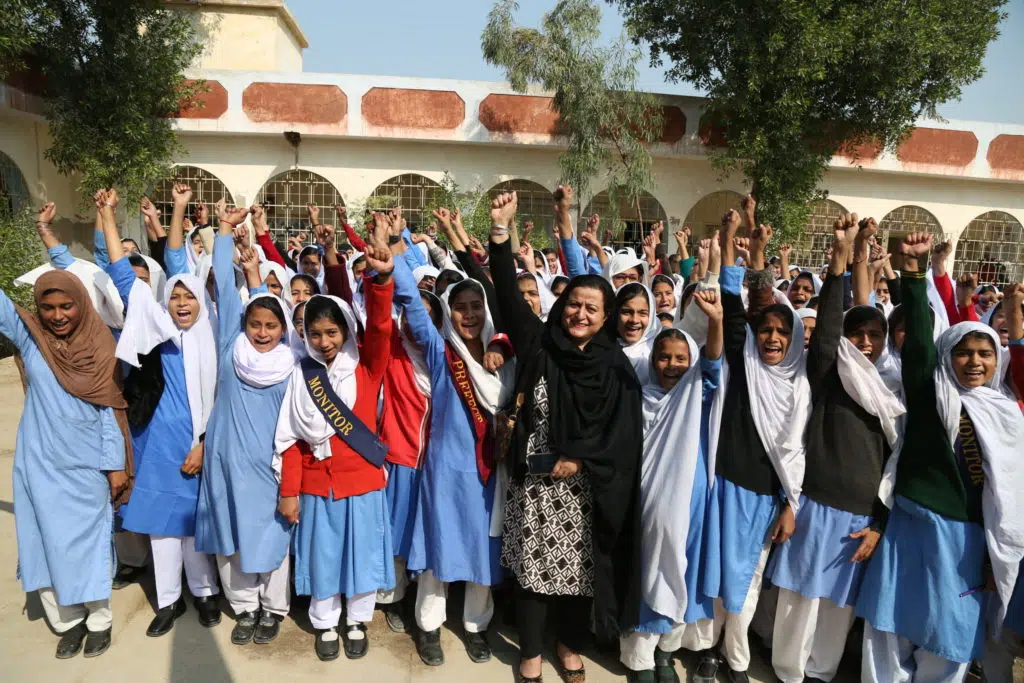
- white-ribbon-alliance
In 2007 the United Nations General Assembly declared the World Day of Social Justice be commemorated annually on Feb. 20. COVID-19, in addition to conflict and climate change, has exacerbated the hardships vulnerable communities have faced these past two years, creating further imbalances in areas like health care, safety, housing, basic rights and more. In 2022, it is expected that 274 million people will need humanitarian assistance and protection, which is the highest figure in decades.
These factors have not dampened spirits though. We’ve seen an incredible rise in conversation, education and charitable giving toward social justice throughout the pandemic. According to Candid, 177 pledges toward racial equity have been made at a $11.6 billion value since 2020. To name a few other initiatives, our Charity Alliance partners are pushing for equitable COVID-19 vaccine distribution , and Global Impact created a tool for employee resource groups .
At Global Impact, we believe in equity for all people and communities around the world. Ahead of the World Day of Social Justice – and as part of our cause of the month feature – let’s take a video journey to learn how our Charity Alliance partners promote the many intersections of social justice and other global causes.
Human Rights Watch
Human Rights Watch defends the rights of people worldwide. They scrupulously investigate abuses, expose the facts widely, and urge those with power to respect rights and secure justice. How they work:
Investigate : Their researchers work in the field in 100 some countries, uncovering facts that create an undeniable record of human rights abuses.
Expose : Human Rights Watch tells the stories of what they found, sharing them with millions of social media and online followers each day. News media often report on their investigations, furthering their reach.
Change : They meet with governments, the United Nations, rebel groups, corporations, and others to see that policy is changed, laws are enforced, and justice is served.
One of their global movements, #BreakTheChains, brings together organizations from around the world to end the chaining of people with mental health conditions.
Partners In Health
Partners In Health’s mission is to provide a preferential option for the poor in health care.
“We are a social justice organization that responds to the moral imperative to provide high-quality health care globally to those who need it most. We strive to ease suffering by providing a comprehensive model of care that includes access to food, transportation, housing, and other key components of healing. We bring the benefits of modern medicine to those who have suffered from the overt and subtle injustices of the world, in the past and in the present. We refuse to accept that any life is worth less than another.”

See the impact Partners in Health has made for 30+ years:
Prison Fellowship International
Prison Fellowship International has programs in prisons around the world that are proven to restore prisoners, help their families and integrate them back into the community. Here’s how they are making a difference:
Offer prisoners hope: Prisoners are one of the least reached groups in the world and they have a plan to reach them. It’s called The Prisoner’s Journey.
Repair broken lives : Restorative justice repairs the harm caused by crime, emphasizing accountability, forgiveness and making amends. When victims, offenders and community members meet to decide how to do that, the results are transformational.
Protect children: They protect children of prisoners from hopeless situations and help restore and rebuild their lives through child sponsorship.
Their unique history: Charles Colson, former aide to President Nixon, served seven months in a federal prison camp for a Watergate-related offense. There, he became convinced the real solution to crime is found through spiritual renewal.
See the story of a man whose life was forever changed when he learned about the power of Jesus’ love through The Prisoner’s Journey:
United Methodist Committee on Relief (UMCOR)
Compelled by Christ to be a voice of conscience on behalf of the people called Methodist, UMCOR works globally to alleviate human suffering and advance hope.
Cristian Schlick is a global missionary who works with migrants from Central America and Mexico in El Salvador. He was commissioned in June 2019 after serving for two years as a Global Mission Fellow, also in El Salvador, focused on human rights issues. Hear about his experience :

White Ribbon Alliance
The White Ribbon Alliance is a global network of reproductive, maternal health and rights advocates campaigning for more resources and the right policies to decrease the preventable deaths of women.
When women are healthy so are their children, families, communities and countries. WRA understands the synergy between sexual, reproductive, maternal, newborn, child, and adolescent health policies and services and works to implement holistic solutions.
White Ribbon Alliance’s approach of educating people about their health and rights, then equipping them to lead change in their own communities, is effective and creates lasting change for generations to come.
Be part of the solution
There are many ways you can join us and our Charity Alliance partners in promoting equality around the world:
- Learn more about the charities focused on social justice and share your support (especially on World Day of Social Justice!)
- Make a gift through your employee giving campaign .
- Inspire others to be a global champion for social justice too.
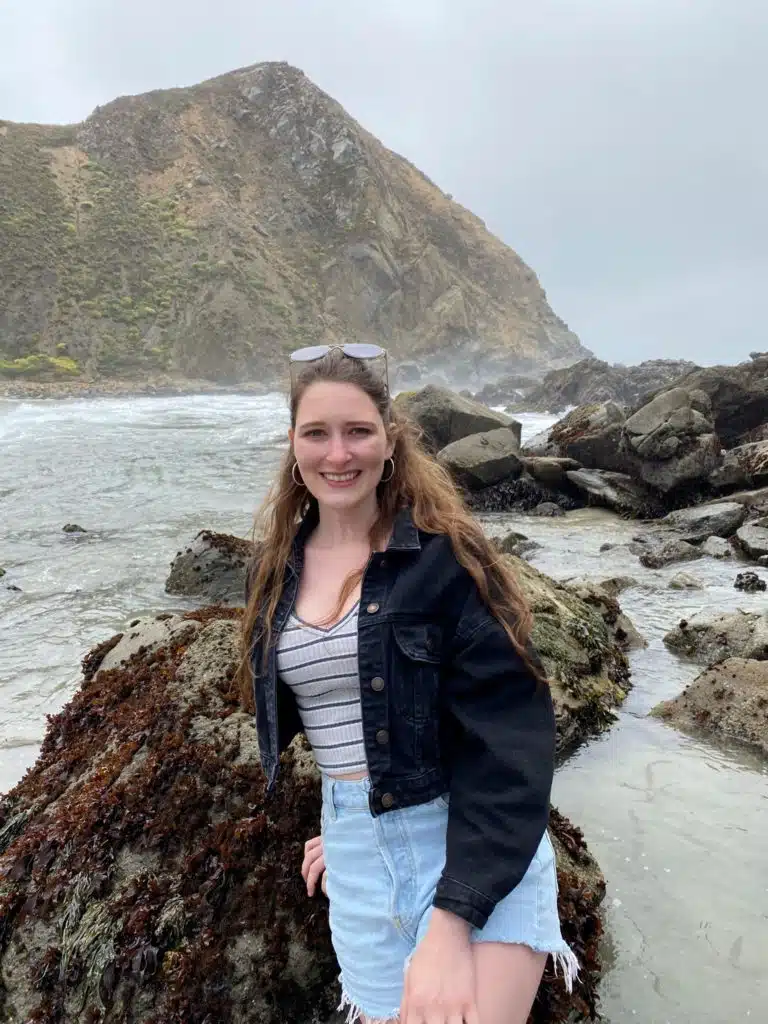
Lauren is a Senior Marketing & Communications Coordinator at Global Impact responsible for developing, managing and implementing key marketing and communications materials. Lauren’s favorite part of her job is learning and promoting the great work of all Global Impact’s partners and clients. Outside of the office, Lauren likes to travel, paddle board and make a mean charcuterie board.
Related Articles
Standing with refugees: five charities making a difference , every number has a story – join the irc this world refugee day, meet heifer’s climate champions: four stories of innovation, ending hunger: four top charities making a difference, giving thanks by giving back: volunteers unite to help relieve food insecurity, three moms providing their kids with a better life, thanks to childfund, if you want more stories like this, sign-up for our newsletter here.
Sign up for our weekly newsletter and other periodic updates. Our newsletter, Greater Giving Weekly, will be sent to you every Thursday and includes the latest philanthropy and Global Impact news. Stay up-to-date on employee engagement, disaster response, the Sustainable Development Goals, corporate social responsibility, giving global, impact investing and more.
Global Impact serves as a trusted philanthropy advisor, intermediary, and nonprofit partner for greater giving. We offer advisory and infrastructure services that drive strategic philanthropy for our nonprofit, public, and private sectors clients. With close to 70 years of experience, we have raised nearly $2.5 billion with our partners for global causes.

Global Impact is part of Global Impact Ventures, a family of mission-driven organizations that serve all of philanthropy for a better world.
U.S. Headquarters
1199 N. Fairfax St. Suite 300 Alexandria, VA 22314 800-836-4620 [email protected]
Quick Links
Sign up for our newsletter, Greater Giving Weekly, and other periodic updates.
© 2004 – 2024 Global Impact. All rights reserved. Global Impact is a 501(c)(3) nonprofit charity registered in the US under EIN: 52-1273585.

- Privacy Overview
- Strictly Necessary Cookies
- Privacy Policy
This website uses cookies so that we can provide you with the best user experience possible. Cookie information is stored in your browser and performs functions such as recognising you when you return to our website and helping our team to understand which sections of the website you find most interesting and useful.
Strictly Necessary Cookie should be enabled at all times so that we can save your preferences for cookie settings.
If you disable this cookie, we will not be able to save your preferences. This means that every time you visit this website you will need to enable or disable cookies again.
More information about our Privacy Policy
The Episcopal saint whose journey for social justice took many forms, from sit-ins to priesthood
Associate Professor of Social Ethics, Union Theological Seminary
Disclosure statement
Sarah Azaransky does not work for, consult, own shares in or receive funding from any company or organisation that would benefit from this article, and has disclosed no relevant affiliations beyond their academic appointment.
View all partners

July 1 is the annual feast day for Episcopal saint Pauli Murray, the first Black woman to be ordained by the denomination: an affirmation of her many contributions not only to the church, but to social justice in the United States.
Saints exemplify “what it means to follow in the footsteps of Jesus and make a difference in the world, and Pauli Murray is one of those people,” Episcopal Bishop Michael Curry said when Murray gained the status of a saint in 2012.
I am a scholar of religion and ethics and have written a biography of Murray and her faith . Throughout her life as an activist, author, lawyer and priest, Murray developed new ways of thinking about justice and identity – ideas important in the U.S. today.
Front line for racial justice
Born in 1910 in Baltimore, Murray jumped into civil rights activism after she graduated from New York’s Hunter College. In the 1940s, she was in the vanguard of Black Christian activists who studied Indian independence leader Mohandas Gandhi’s practice of nonviolent direct action and applied it to the struggle for racial justice in the U.S.
More than a decade before Rosa Parks’ arrest for refusing to give up her bus seat to a white rider, Murray was arrested for integrating an interstate bus. She organized sit-ins in segregated restaurants in Washington, D.C., a strategy other activists famously replicated in Greensboro, North Carolina .
In 1956 Murray published “ Proud Shoes ,” a family memoir that brought attention to how central sexual violence was in the history of U.S. slavery . Murray offered her family – who was Black, white and Indigenous, and whose ancestors were both enslaved and free – as an emblem of the nation, and an example of the history all Americans needed to reckon with.

Feminist and priest
As a lawyer, Murray used her career to advocate for racial justice. But she also grew increasingly involved with advocacy for women’s rights, to which she made landmark legal contributions.
In the 1960s, Murray laid the groundwork by encouraging feminist lawyers to move away from seeking special protections for women and instead argue for equal rights. Supreme Court Associate Justice Ruth Bader Ginsburg credited Murray with teaching her how appealing to the equal protection clause of the 14th Amendment could be an effective method to fight sex discrimination. After hearing Murray argue that there should be an NAACP – the country’s oldest civil rights organization – just for women, feminist leader Betty Friedan invited Murray to a strategy session where the National Organization for Women was founded.
A lifelong Episcopalian, Murray made a dramatic-seeming move to enroll in a seminary when she was in her mid-60s. Yet to Murray, it made perfect sense. She described preparing for the ministry as one more way to address questions of human rights and social justice.
Murray entered seminary before the Episcopal Church began ordaining women and organized with others to push for women’s ordination. In January 1977, she became one of the first women, and the first Black woman , to be ordained.
Murray indeed contained multitudes, including when it came to gender identity . At some points in life Murray identified as a man; at others, as a woman. Murray was in long-term romantic relationships with women, but did not publicly identify as lesbian or queer.
When she prepared her papers to be archived , Murray included writings about her multiple gender and sexual identities so they would be available for future generations. During her life, categories like “nonbinary” or “trans” were not used, but many scholars and admirers today see her as an early icon for transgender people.
Written into law
Another way Murray’s work seems prescient today is her focus on what’s now called “ intersectionality ”: how multiple aspects of a person’s identity, such as race, gender, income and nationality, intersect to shape their privilege or oppression.
A prime example is Murray’s phrase “ Jane Crow ” – a spin on “ Jim Crow ” – which she coined to describe Black women’s experiences of being discriminated against because of racism and sexism. In a world where “male supremacy” and “white supremacy” are prevalent, a Black woman “finds herself at the bottom of the economic and social scale,” Murray wrote in 1947 .
Murray’s “Jane Crow” has made important contributions in American history . In 1964, for example, she employed the concept to keep “sex” as a category in Title VII of the 1964 Civil Rights Act , making it unlawful to discriminate against someone in employment based on race, color, national origin, sex or religion. Some lawmakers thought “sex” was a distraction in a law that focused on discrimination based on race. As a Black woman, Murray argued that both race and sex needed to be included if the law were to protect people like her.

Murray’s insistence on including sex in Title VII has become essential to LGBTQ rights today. The landmark 2020 Supreme Court ruling in Bostock v. Clayton County prohibits employers from firing people because they are gay or trans. Associate Justice Neil Gorsuch, who wrote the majority opinion, wrote, “It is impossible to discriminate against a person for being homosexual or transgender without discriminating against that individual based on sex.”
Murray’s capacious sense of being a human, which she gleaned in part from her own experiences, inspired her many contributions to social justice. In a letter to friends soon after her ordination, Murray wrote , “we bring our total selves to God, our sexuality, our joyousness, our foolishness. … I’m out to make Christianity a joyful thing.”

Union Theological Seminary is a member of the Association of Theological Schools.
- Transgender
- Christianity
- Episcopal church
- Intersectionality
- Religion and society
- Seminaries and religious teaching
- The Association of Theological Schools
- Association of Theological Schools

Dean, Faculty of Education

Lecturer in Indigenous Health (Identified)

Social Media Producer

PhD Scholarship

Senior Lecturer, HRM or People Analytics

Dr. Opal Lee: The Grandmother of Juneteenth and Her Journey to Make It a National Holiday
D r. Opal Lee, often referred to as the “Grandmother of Juneteenth,” has played a pivotal role in the journey to make Juneteenth a national holiday. Her tireless activism, commitment to social justice, and dedication to educating others about the significance of this day have left an indelible mark on American history. This blog post explores the life and legacy of Dr. Opal Lee, highlighting her contributions to making Juneteenth a national holiday and the broader impact of her work.
Who is Dr. Opal Lee?
Early life and background.
Born on October 7, 1926, in Marshall, Texas, Opal Lee grew up during a time of significant racial segregation and discrimination. Her early experiences with racism and her determination to overcome adversity shaped her lifelong commitment to civil rights and social justice.
Career and Activism
Lee spent much of her career as an educator in Fort Worth, Texas. Her passion for teaching and community involvement extended beyond the classroom, as she became increasingly involved in civil rights activism. Lee’s dedication to equality and justice is evident in her work with various organizations and her efforts to improve the lives of those in her community.
The Significance of Juneteenth
Historical context.
Juneteenth, also known as Emancipation Day or Freedom Day, commemorates June 19, 1865, when Union General Gordon Granger arrived in Galveston, Texas, and announced that all enslaved people were free. This proclamation came more than two years after President Abraham Lincoln’s Emancipation Proclamation and marked a significant moment in the struggle for freedom and equality in the United States.
Cultural and Social Importance
For generations, Juneteenth has been celebrated by African American communities as a day of remembrance, reflection, and celebration of freedom. The day is marked by various festivities, including parades, cultural events, and educational activities that honor the resilience and contributions of Black Americans.
Dr. Opal Lee’s Campaign for Juneteenth
The walk to washington.
In 2016, at the age of 89, Dr. Opal Lee began her symbolic walk from Fort Worth, Texas, to Washington, D.C., to raise awareness and garner support for making Juneteenth a national holiday. Her journey, which covered over 1,400 miles, was a testament to her determination and passion for the cause. Along the way, Lee met with community leaders, politicians, and citizens, educating them about the significance of Juneteenth and the importance of recognizing it as a national holiday.
Advocacy and Education
Lee’s advocacy efforts extended beyond her walk. She organized events, spoke at schools and universities, and collaborated with various organizations to promote the recognition of Juneteenth. Her tireless work included gathering signatures for petitions and lobbying lawmakers to support legislation that would make Juneteenth a federal holiday.
Legislative Success
Dr. Opal Lee’s dedication and perseverance paid off in June 2021, when President Joe Biden signed the Juneteenth National Independence Day Act into law, officially making Juneteenth a federal holiday. The legislation passed with overwhelming bipartisan support, reflecting the widespread recognition of the day’s historical and cultural significance.
The Broader Impact of Dr. Opal Lee’s Work
Promoting awareness and education.
Dr. Opal Lee’s efforts have significantly increased awareness and understanding of Juneteenth. Her work has helped to educate people about the history of slavery, the fight for freedom, and the ongoing struggle for racial equality. By bringing Juneteenth into the national spotlight, Lee has ensured that future generations will remember and honor this important part of American history.
Inspiring Future Activists
Lee’s activism serves as an inspiration to future generations of activists and leaders. Her unwavering commitment to justice and equality demonstrates the power of individual action in effecting change. Lee’s story encourages others to take up the mantle of advocacy and continue the work of building a more just and equitable society.
Strengthening Community and Cultural Bonds
The recognition of Juneteenth as a national holiday has helped to strengthen community and cultural bonds. Celebrations of Juneteenth provide opportunities for reflection, education, and unity, fostering a greater sense of connection and solidarity among diverse communities.
Final Thoughts
Dr. Opal Lee’s remarkable journey and tireless advocacy have transformed Juneteenth from a regional celebration into a nationally recognized holiday. Her dedication to justice, education, and community has left an enduring legacy that will continue to inspire and uplift future generations. As we celebrate Juneteenth each year, we honor the contributions of Dr. Opal Lee and the countless others who have fought for freedom and equality. Their efforts remind us of the importance of remembering our history and continuing the work of building a more inclusive and just society.
![Dr. Opal Lee, often referred to as the “Grandmother of Juneteenth,” has played a pivotal role in the journey to make Juneteenth a national holiday. Her tireless activism, commitment to social justice, and dedication to educating others about the significance of this day have left an indelible mark on American history. This blog post explores […] Dr. Opal Lee, often referred to as the “Grandmother of Juneteenth,” has played a pivotal role in the journey to make Juneteenth a national holiday. Her tireless activism, commitment to social justice, and dedication to educating others about the significance of this day have left an indelible mark on American history. This blog post explores […]](https://img-s-msn-com.akamaized.net/tenant/amp/entityid/BB1plKKX.img?w=768&h=511&m=6&x=176&y=243&s=66&d=66)

Justice for All? Why We Have an Access to Justice Gap in America—and What Can We Do About It?
- June 13, 2024
- Nora and David Freeman Engstrom; Q&A with Professor Pamela Karlan
- Deborah L. Rhode Center on the Legal Profession
- Share on Twitter
- Share on Facebook
- Share by Email
On a recent episode of the Stanford Legal podcast, Professors David and Nora Freeman Engstrom , co-directors of Stanford Law School’s Deborah L. Rhode Center on the Legal Profession , delve into what they describe as an access to justice crisis in the United States. In three-quarters of civil cases in state courts, they say, at least one party lacks a lawyer, usually because they cannot afford one. And, as they explain, this pro se crisis is just a small part of a much larger problem.
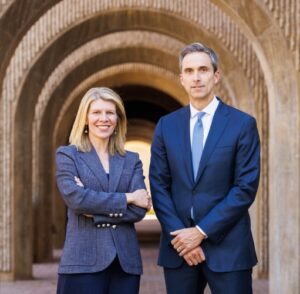
Stanford Legal co-host Pam Karlan , the Kenneth and Harle Montgomery Professor of Public Interest Law, interviewed the Engstroms about the roots of the access to justice crisis, how it impacts individuals and families—and what can be done to fix it.
The following is an edited version of the full podcast transcript, which can be found here .
Pam Karlan: On one hand, people often think there are too many lawyers in the United States, but then there’s this countervailing issue of there not being enough legal services.
Nora Freeman Engstrom: In the United States, we have plenty of lawyers, but people’s ability to get access to justice is actually pretty dismal. In three-quarters of civil cases in state court—and state court is where the vast majority of cases are litigated in this country—one side lacks a lawyer. Sometimes, both sides lack a lawyer.
Pam Karlan: What kind of cases are we talking about here where three-quarters of the people don’t have lawyers?
David Freeman Engstrom: Generally, these are low-dollar, but highly consequential cases. They tend to be debt collection actions, evictions, mortgage foreclosure actions, and a lot of family law claims, including child support enforcement actions. There are approximately 15 million cases a year where at least one side lacks a lawyer. Another feature of these cases also really stands out: These cases tend to pit an institutional plaintiff—for instance, a bank, a credit card company, a corporate landlord, a municipal housing authority, or some other government agency—against an individual defendant without a lawyer.
Pam Karlan: And we’re not even counting in the cases where people don’t get to court in the first place: individual plaintiffs who’ve been defrauded or wronged, who would go up against a corporate defendant if they had a lawyer or the resources.
Nora Freeman Engstrom: Yes, the pro se crisis—all those folks in court without counsel—is really just the tip of the iceberg. Below all these folks we see are all these cases that never make it into court at all. These are people with rights that are violated but never vindicated. And it’s exactly as you say: It’s the person who has an uninhabitable apartment, but never seeks to enforce her right for habitable housing, or the person who’s jerked around by the insurance company and never gets the claim paid and just ultimately shrugs her shoulders and gives up, or the woman who’s being abused by her spouse and never gets that domestic violence restraining order that she needs.
Pam Karlan: Why can’t people get lawyers for these kinds of cases?
David Freeman Engstrom: The Stanford Law Review had a symposium last year on access to justice, and Nora and I wrote an introductory essay in that symposium that I can commend to the listeners. It’s titled “ The Making of the A2J Crisis ,” and in that essay, we roll through all the different causes.
One issue is attribution. Many Americans don’t even necessarily know that the problem that they have is a legal problem in the first place, and that’s really important to keep in mind. They don’t even know that they should resolve a certain matter by going to court.
Another issue is expense. Legal services are really expensive. Anyone middle class or below is priced out of the market for legal services that cost, on average, $300 an hour. And, although there is some legal aid to help people, there’s clearly not enough , and, adding to the insufficiency, there are restrictive rules that limit what types of legal services can be provided and by whom.
Pam Karlan: But why are we seeing such an uptick in pro se litigation rates? There’s some evidence that, over the past few decades, pro se rates have more than doubled.
David Freeman Engstrom: Yes, rates of pro se litigation is up sharply, although assessing the exact amount is challenging. But why?
In the Stanford Law Review essay, we note that, interestingly, poverty rates haven’t really changed so much in recent decades. What has increased is economic precarity. Most American households can’t really weather any significant financial hit, and so when they get hit with health care bills that they can’t pay, or fall behind on their rent, they descend into poverty and debt collection actions, and evictions frequently follow—and it is these cases that are really choking courts. These cases overwhelmingly end in default judgments: The defendant fails to show up because the defendant has no meaningful legal help.
Nora Freeman Engstrom: All this is bound up together. For example, once your wages are garnished pursuant to a default judgment, it sure is harder to pay rent, and if you’re not paying rent, then it sure is easy to get evicted. And it cuts the other way, too. Once you’re evicted, it’s really hard to keep your job, and it’s hard to keep your family together, and so legal problems have a way of cascading on one another.
Pam Karlan: And none of these cases that we are talking about would be done on contingent fee cases, correct?
Nora Freeman Engstrom: That’s mostly right. The access to justice problems David and I are focused on are particularly acute in areas where lawyers charge by the hour—areas involving housing, families, and debt collections. But they’re not isolated to these areas. A lot of people think, for example, that there’s no access to justice problem in the personal injury sphere because, if you’re hurt, you can get a lawyer on a contingency fee basis. That’s right if you’re a high wage earner and you’re really seriously injured. But it is not necessarily the case if you are an elderly person or a child. As I’ve written about , there are access to justice problems that afflict certain areas of the personal injury ecosystem too.
David Freeman Engstrom: Right now in the American legal system, the most numerous type of case is consumer credit debt collection actions. If you look back 30 or 40 years, torts and contract actions were neck and neck on state court dockets. Now, torts have largely fallen away for a variety of reasons, and contract claims, which include debt collection claims, are ascendant. The question is: what happened? It is a really interesting part of all of this and something that you really need to understand to have a full, 360-degree view of the problem. The debt collection industry has learned to leverage a lot of technology, what you would call robotic process automation, to build the pleadings and everything else you need to do in order to generate legal filings and then get them into court. About 60 percent of these cases are brought by debt buyers–that is, entities that buy tranches of debt from the originators, and then use all of this automation to assembly-line filings. However, restrictive rules that say that only lawyers can practice law mean that technology is not nearly as available to the individual defendants on the other side.
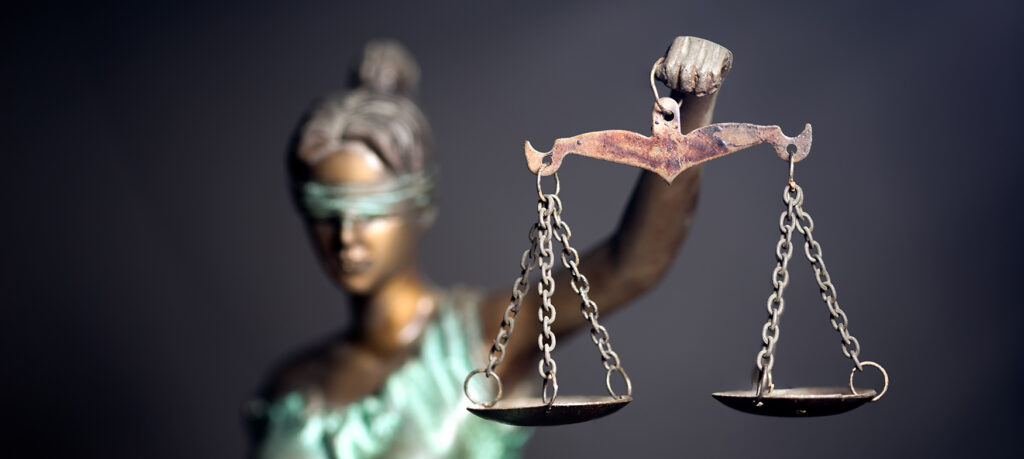
Pam Karlan: Let’s talk about restrictions we have on the provision of legal services. The United States is different from other countries where there are all sorts of people who provide legal services. Nora, could you tell us a little bit about how we ended up in this situation?
Nora Freeman Engstrom: As we have said, lawyers are expensive and they’re the only game in town. I call this the two-door problem, which is: If you have a legal problem, or you’re trying to vindicate or defend your legal rights, and you’re going to make your way into court, you’ve got two choices in the United States. You can represent yourself. Or you can hire one of these very expensive lawyers. You can imagine a third choice, right? Like, some sort of “lawyer lite.” Like when I have a sprained ankle, I don’t need to go to a full MD. I can go to a physician’s assistant or a nurse practitioner. Some problems are smaller and more easily addressed—and often better addressed—by someone without a law degree. But in the United States, we don’t have a third door. We have no third option—nothing between a full lawyer and going it alone.
Now, in terms of how we ended up in this situation, it’s fascinating! I am just finishing a paper entitled Auto Clubs and the Lost Origins of the Access-to-Justice Crisis that I wrote with James Stone, a Stanford Law grad who was a fellow at the Rhode Center last year, that sheds light on this. The paper tells this origin story by recovering the lost history of auto clubs. We explain that, in addition to the roadside assistance that we have today, the AAA of yesteryear provided legal services, and actually a lot of legal services. You could go to your auto club if you were in a car accident, and you thought the other person was at fault, and they would represent you. Or, if you were at fault, they would represent you. They would represent you even in criminal matters and provide a defense. Essentially, by joining an auto club, you had a lawyer for all things auto.
Pam Karlan: So, what happened? Why did the auto clubs stop providing legal services?
Nora Freeman Engstrom: It’s a crime in nearly every state for a non-lawyer to supply legal advice or assistance, and those laws have been around for a long time. It’s these laws, called unauthorized practice of law restrictions, that create the two-door problem I just discussed.
Now, auto clubs weren’t running afoul of those laws because lawyers employed by the clubs were providing legal assistance. So, you might be thinking: how is it that a lawyer providing legal assistance is going to run afoul of an unauthorized practice of law rule, designed to prevent the practice of law by nonlawyers? In the 1920s and 30s, the organized bar developed an argument. Never before had there been rules banning what was called “the corporate practice of law,” which is to say lawyers working for non-law firms. Yet, in the 1920s and 30s, the bar simply created a new prohibition. Pursuant to this new prohibition, not only can nonlawyers not practice law. Additionally, if a lawyer is not self-employed or employed at a law firm, the lawyer is also engaged in the unauthorized practice of law. That’s also a no-no. A lawyer’s relation to his client should be personal, and the responsibilities of the lawyer to the client should be direct, they said. Pursuant to this new idea, the bar argued that it’s improper to have things like auto clubs where the lawyers were working for the club and providing legal services.
So, peddling this newly minted prohibition, the bar shut down the auto clubs. And this wasn’t an altruistic move. They weren’t worried about consumer harm. All evidence suggests that the auto clubs were booming, and people were quite thrilled with the services that they received. We argue that the bar fashioned a new argument at a time when the organized bar was under a lot of financial strain, and they wanted to crush the competition.
Pam Karlan: Can you tell us a little bit about some of the innovations that you’re now seeing to try to address the access to justice problems we’ve discussed?
David Freeman Engstrom: There is a movement afoot in the United States, across many states, to relax the usual rules that say that only lawyers can practice law and to try to open up a space for non-lawyer alternative legal services providers. That can include what I refer to sometimes as “human non-lawyers.” These would be along the lines of a nurse practitioner, or a physician assistant. But these providers could also include non-human non-lawyers, i.e., software-driven models of legal provision. This is an important moment, and I think the success or failure of this movement to open up this space for new types of legal services, and new delivery models, is really going to shape the future of the civil justice system. We have advised multiple state supreme courts on how to responsibly relax those rules. And we’ve also done what we think is some really neat empirical work looking at what has happened in the first two states that did this, Utah and Arizona. In both states, there was a liberalization of these rules to create a little more space for non-lawyer legal services providers.
Nora Freeman Engstrom: The big question is: what happens if you relax Rule 5.4? That’s the modern version of the rule, created in the 1920s and 30s, that says lawyers have to practice in law firms or as solo practitioners. They can’t work for things like auto clubs.
David Freeman Engstrom: We are seeing a lot of interesting new service delivery models. Law firms have started to develop tiered legal services, with, for instance, a purely software-based, do-it-yourself tier at the bottom. In the middle, something that involves perhaps a paralegal or a paraprofessional. And then at the top, full representation by a lawyer.
Given the tangle of unauthorized practice of law restrictions, in most states, law companies like LegalZoom are currently limited to what we call document assembly. But, in Utah and Arizona, LegalZoom is using the rule relaxation to hire lawyers to supplement those document assembly services. A lot of non-law companies that just provide, for example, immigration services can now layer in some legal services, so they can provide more wraparound services that they couldn’t offer previously. There’s a company in Utah that helps people achieve expungement of their criminal record in a software-based way. It’s a very robust user-friendly platform.
Pam Karlan: Can you touch on what is happening with generative AI?
David Freeman Engstrom: One of the many things that generative AI brings to the table is “mapping”—the ability to take a plain language description of a legal problem that someone is experiencing. It can take a plain-language description and map it to what we would call a legal ontology in order to understand what the possible actions and outcomes would be, and then come back to the individual who would otherwise go without meaningful legal help with a roadmap for what to do next. That’s real promise, but also, frankly, peril. Generative AI makes these tools much easier to create, but we need to ensure that these tools are high quality and trustworthy.
Listen to the Full Podcast
David Freeman Engstrom and Nora Freeman Engstrom co-direct SLS’s Deborah L. Rhode Center on the Legal Profession , the premier academic center working to make the civil justice system more accessible, equitable, and transparent.
David, the LSVF Professor in Law and an expert in civil procedure and administrative law, focuses his current work on the future of courts and legal services in the age of AI. His book, Legal Tech and the Future of Civil Justice, was published last year. He currently serves as the Reporter for the American Law Institute’s Principles of the Law, High-Volume Civil Adjudication, which will offer courts guidance on the millions of low-dollar but consequential cases, including debt and eviction, that shape Americans’ lives each year. He also co-founded the Filing Fairness Project, an ambitious, multi-state collaboration to modernize court technologies and increase access.
Nora, the Ernest W. McFarland Professor of Law, is a nationally recognized expert in both tort law and legal ethics. In her far-ranging scholarship, she explores the day-to-day operation of the tort system, including the system’s interaction with alternative compensation mechanisms, such as no-fault automobile insurance and the Vaccine Injury Compensation Program. For the American Law Institute, she serves as a Reporter for the Third Restatement of Torts: Miscellaneous Provisions; a Reporter for the Third Restatement of Torts: Medical Malpractice (read recent coverage here ); and as an Adviser to the Third Restatement of Torts: Remedies.

- Kindle Store
- Kindle eBooks
- Religion & Spirituality
Promotions apply when you purchase
These promotions will be applied to this item:
Some promotions may be combined; others are not eligible to be combined with other offers. For details, please see the Terms & Conditions associated with these promotions.
Buy for others
Buying and sending ebooks to others.
- Select quantity
- Buy and send eBooks
- Recipients can read on any device
These ebooks can only be redeemed by recipients in the US. Redemption links and eBooks cannot be resold.

Download the free Kindle app and start reading Kindle books instantly on your smartphone, tablet, or computer - no Kindle device required .
Read instantly on your browser with Kindle for Web.
Using your mobile phone camera - scan the code below and download the Kindle app.

Image Unavailable

- To view this video download Flash Player
Follow the author

Journey toward Justice (Turning South: Christian Scholars in an Age of World Christianity): Personal Encounters in the Global South Kindle Edition
- Part of series Turning South: Christian Scholars in an Age of World Christianity
- Print length 274 pages
- Language English
- Sticky notes On Kindle Scribe
- Publisher Baker Academic
- Publication date November 5, 2013
- File size 2912 KB
- Page Flip Enabled
- Word Wise Enabled
- Enhanced typesetting Enabled
- See all details

- Customers Also Enjoyed
- In This Series
- By Nicholas Wolterstorff
- Ethics & Morality
- Religion & Spirituality

Editorial Reviews
From the back cover, about the author, product details.
- ASIN : B00G2DRBH4
- Publisher : Baker Academic (November 5, 2013)
- Publication date : November 5, 2013
- Language : English
- File size : 2912 KB
- Text-to-Speech : Enabled
- Screen Reader : Supported
- Enhanced typesetting : Enabled
- X-Ray : Not Enabled
- Word Wise : Enabled
- Sticky notes : On Kindle Scribe
- Print length : 274 pages
- Page numbers source ISBN : 0801048451
- #1,160 in Christian Ethics (Kindle Store)
- #1,566 in Religious Studies - Philosophy
- #3,857 in Ethics in Christian Theology
About the author
Nicholas wolterstorff.
Discover more of the author’s books, see similar authors, read author blogs and more
Customer reviews
Customer Reviews, including Product Star Ratings help customers to learn more about the product and decide whether it is the right product for them.
To calculate the overall star rating and percentage breakdown by star, we don’t use a simple average. Instead, our system considers things like how recent a review is and if the reviewer bought the item on Amazon. It also analyzed reviews to verify trustworthiness.
- Sort reviews by Top reviews Most recent Top reviews
Top reviews from the United States
There was a problem filtering reviews right now. please try again later..
Top reviews from other countries
Report an issue
- Amazon Newsletter
- About Amazon
- Accessibility
- Sustainability
- Press Center
- Investor Relations
- Amazon Devices
- Amazon Science
- Sell on Amazon
- Sell apps on Amazon
- Supply to Amazon
- Protect & Build Your Brand
- Become an Affiliate
- Become a Delivery Driver
- Start a Package Delivery Business
- Advertise Your Products
- Self-Publish with Us
- Become an Amazon Hub Partner
- › See More Ways to Make Money
- Amazon Visa
- Amazon Store Card
- Amazon Secured Card
- Amazon Business Card
- Shop with Points
- Credit Card Marketplace
- Reload Your Balance
- Amazon Currency Converter
- Your Account
- Your Orders
- Shipping Rates & Policies
- Amazon Prime
- Returns & Replacements
- Manage Your Content and Devices
- Recalls and Product Safety Alerts
- Conditions of Use
- Privacy Notice
- Consumer Health Data Privacy Disclosure
- Your Ads Privacy Choices
- Social Justice
- Environment
- Health & Happiness
- Get YES! Emails
- Teacher Resources
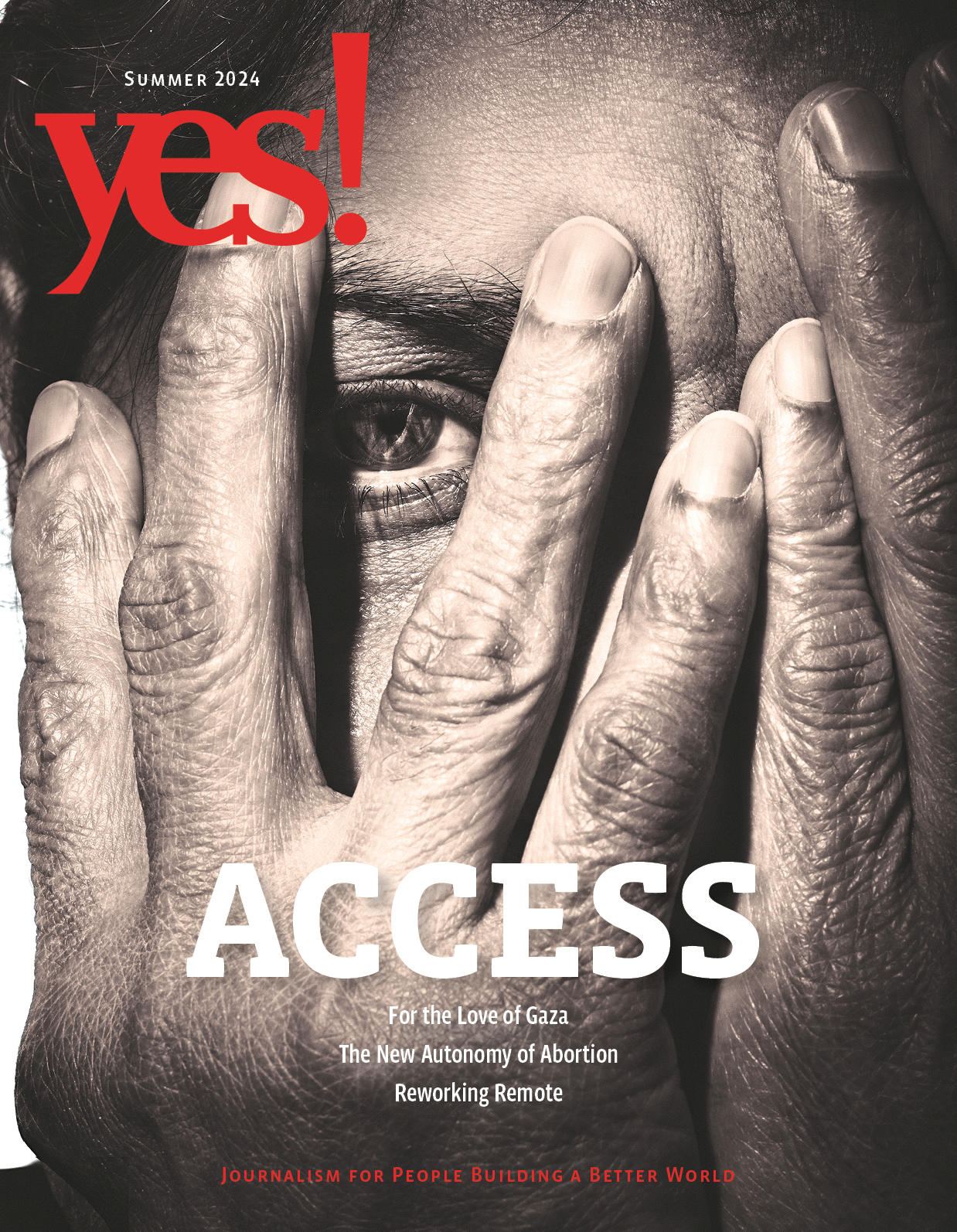
- Give A Gift Subscription
News Based on facts, either observed and verified directly by the reporter, or reported and verified from knowledgeable sources.
Analysis Based on factual reporting, although it incorporates the expertise of the author/producer and may offer interpretations and conclusions.
Little Gaza’s Kitchen Brings a Taste of Home to Displaced Palestinians

During the golden hour in Quezon City, Philippines, a special Palestinian food pop-up event wraps up. The event, led by Little Gaza, a community of Palestinian and Palestinian-Filipino refugees who recently evacuated Gaza, is taking place on a humid March afternoon in Manila. The aromas from spice-infused Palestinian food fills the common area of an apartment building where newly resettled refugees are being housed.
The pop-up’s chefs greet a never-ending line of customers who are eager to both taste homemade meals— kabsa , maqluba , chicken musakhan , and other delicacies—and express their solidarity with Palestine. Each plate costs up to 150 Philippine pesos (roughly $2.70) per order, with the funds supporting Little Gaza’s Kitchen, a group of food businesses run by Palestinian refugee families rebuilding their lives in the Philippines because the Israeli government is violently occupying their home.
With nine kitchens shared among 16 families, Little Gaza’s Kitchen hosts and participates in occasional events, including a halal food bazaar held during Ramadan, where their food offerings sold out quickly. Outside of these occasional events, Little Gaza’s Kitchen operates as a food delivery service , with all meals cooked in their homes.
As the day slows down, a group of Filipino Muslims and Palestinian refugees make their way to the apartment’s rooftop to gather for iftar, the meal eaten at sunset to break their fast during Ramadan. They sit cross-legged on carpets, distributing tubs of chicken biryani as they prepare to pray. While the adults pray, the children play, unapologetically loud and alive. Watching them play left me wondering what it’s like to grow up as a child in Palestine and what it’s like for these families to be forced to build their lives again.
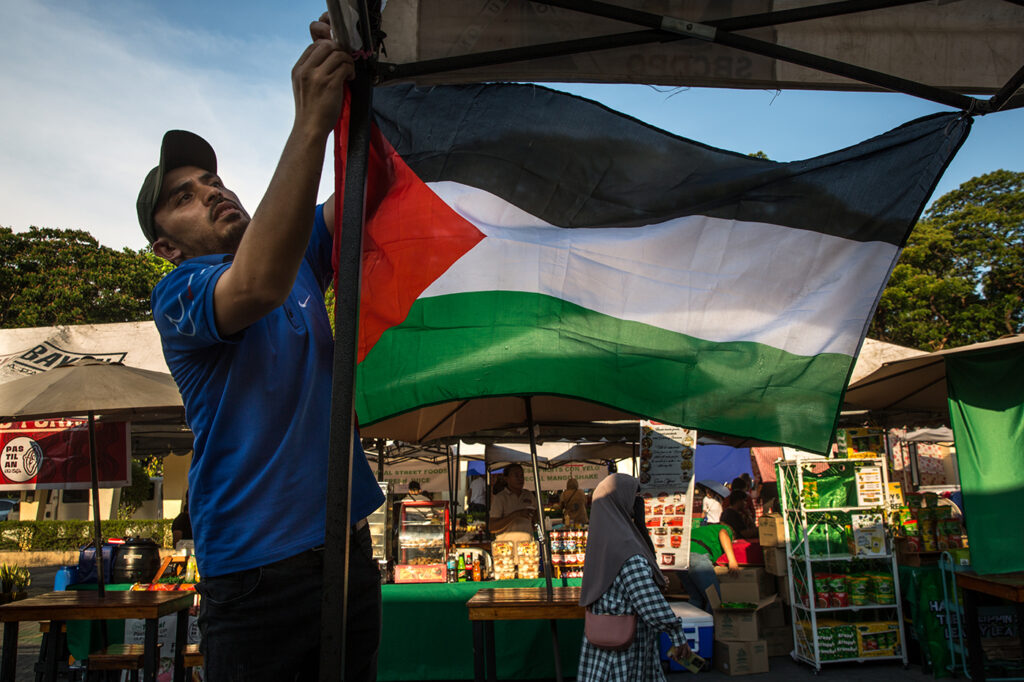
The Arduous Journey of Repatriation
The Philippines has become a refuge to more than 170 Palestinians since November 2023, with 70 of them living in a residential area in Quezon City, now known as Little Gaza.
Since October 2023, Palestinians have been fleeing Gaza to escape Israel’s genocidal military incursion. Though Egypt is the only exit point to flee Gaza at this time, the majority of Egypt’s borders are closed. Only few may enter, like foreign passport holders, the wounded, and those economically resourced to evacuate.
Today, there are nearly 5 million Palestinian refugees . Jordan hosts the largest number of this population, with more than 2 million Palestinian refugees, followed by Syria with 584,000 and Lebanon with 491,000. The United Nations Relief and Works Agency operates these refugee camps, including 19 more in the West Bank .
The thread between Gazan refugees and the Philippines is tied by the Filipino-Palestinians who uprooted and found a home in Palestine. There are more than 200 Filipinos living in Palestine , and 137 of them in Gaza. The majority of Filipinos in Gaza are women married to Palestinians and are dependents of them. Since October, they have been urged by the Philippine government to escape Gaza with their families.
Yasmin, a science teacher who fled Gaza with her children in February, has now settled in the Philippines. Yasmin has dual Palestinian-Filipino citizenship since she was born in the Philippines. When she was forced to leave Gaza, the Philippine embassy provided her a path to repatriation.
Although reluctant, Yasmin evacuated Gaza for the sake of her children, a common decision among Palestinian-Filipino women married to Palestinian spouses: “I didn’t want to leave. Because my husband and my father [were] still there… they weren’t approved to be evacuated,” Yasmin shares.
Refugees who only have Palestinian citizenship have to pay $5,000 to the Egyptian government to escape Gaza, with other escape routes demanding up to double this cost. The cost is an obstacle for many Gazans, including Yasmin’s husband and father.
“You know, we have a great life in Gaza,” she says. “We have beautiful houses. We had a car. We had a beautiful routine. I am a science teacher back there at the United Nations School, and the war began.”
Because the Philippine government’s initial support was limited , Gazan refugees relied on community-based assistance to sustain their livelihoods.
The Moro -Palestinian Cooperation Team (MPACT) has been supporting Little Gaza in managing administrative concerns and taking care of monthly bills. Kamilah Dimaporo Manala-o, one of MPACT’s cofounders, shares that the seven-person organization was birthed out of the need to support the Gazan evacuees.
“My husband and I—together with five other individuals—put up and manage Little Gaza,” says Manala-o. “When we saw how serious this was, the weight of the responsibility and commitment, we agreed that together we are the Moro-Palestinian Cooperation Team.”
The team raises funds to pay $5,090 (or 280,000 Philippine pesos) of monthly rent for 16 families and other bills, like water and electricity. Little Gaza’s Kitchen then became a viable option to sustain the refugee community.
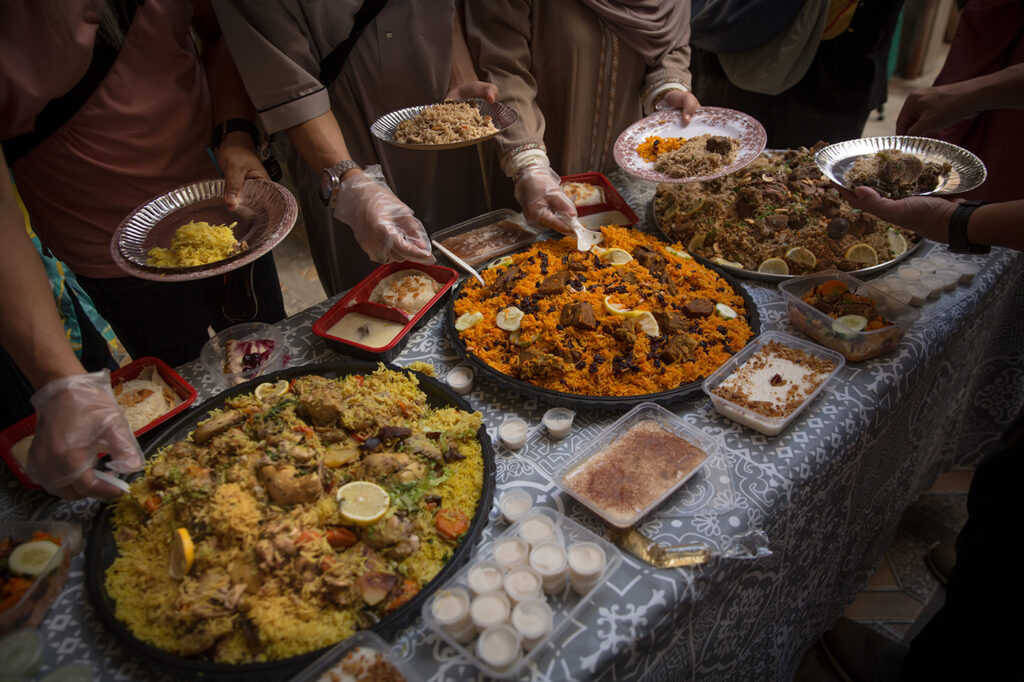
The Diversity of International Solidarity
Other grassroots organizers in Manila, most of whom are artists, have also come together to support the Palestinian refugee community. When Little Gaza’s Kitchen needed to use social media and branding to attract customers, artist and grassroots organizer Didi Nyunyu volunteered to design each business’s logos and menus free of charge.
Nyunyu, who is disabled, finds this act of solidarity more accessible than protests and rallies. Due to chronic radiculopathy, it can be challenging and even dangerous for Nyunyu to participate in public demonstrations for Palestinian solidarity. Since there is an assumption that the real fight is on the streets, Nyunyu says, “Even amongst comrades, I feel like an afterthought most of the time.”
Collaborating with Palestinian refugees to brainstorm and design the brands for their food businesses is far more doable for Nyunyu. “It is nice to find this tiny place in the movement,” Nyunyu says.
When designing for Little Gaza’s Kitchen, Nyunyu considered how to make each logo unique. “What if we distinguished each family by color?” Because Little Gaza is starting to build a legacy of bringing Palestinian food to the Philippines, Nyunyu was compelled to move in a more personalized direction: “Let’s just draw the faces of these people to draw them closer to Filipinos!”
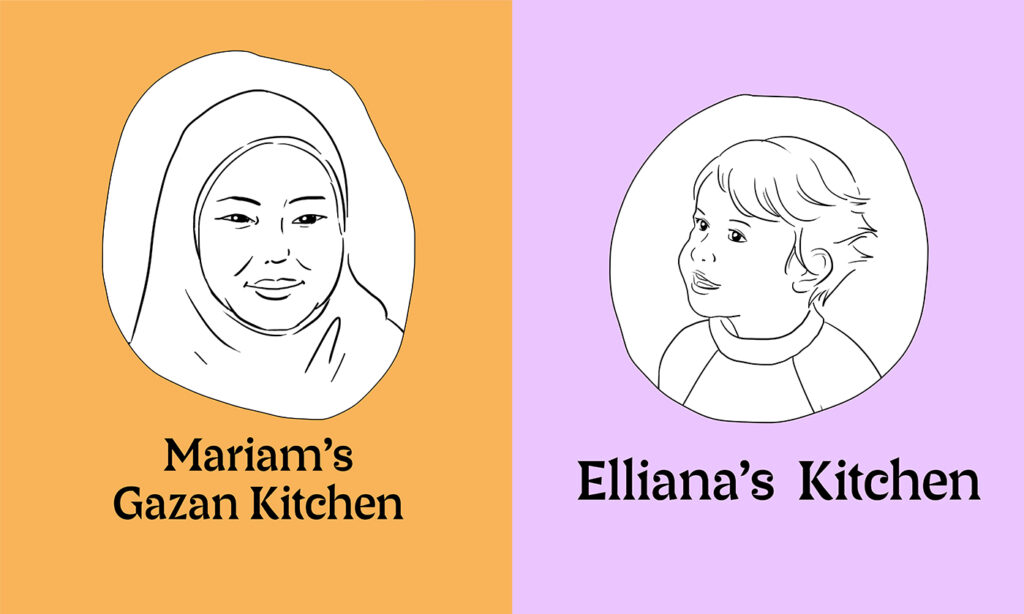
With their consent, visual sketches of family members ended up in each food business’s logo, which Nyunyu considers a more humanizing approach: “[We chose] logos with people’s faces so that [customers] can identify [the families]… bringing this closer to the [Filipino] people and making the kitchens more identifiable with the people behind them.”
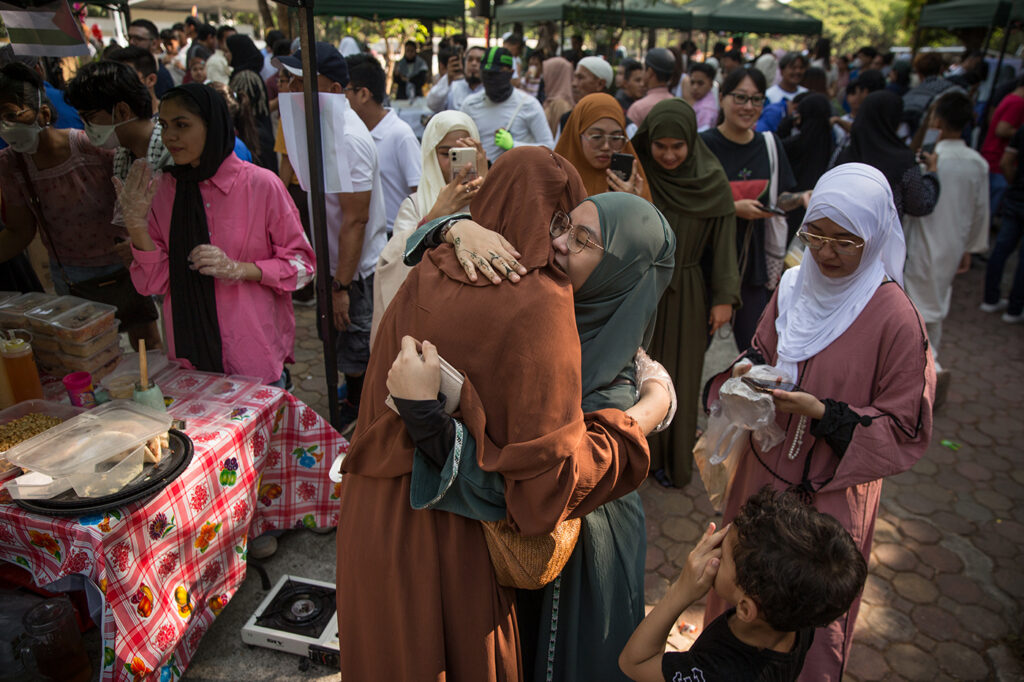
The Hope to Return Home
Most of the Palestinian refugees I spoke with shared a hope for a permanent cease-fire that will allow them to return home.
“Palestinians own the land,” Yasmin says. She added, “And we hope… when the war stops, we leave to go back there. Because we grew up there, we have our memories there. We have our relatives, our loved ones—we really want to get back there.”
While Yasmin says she is grateful for the Philippines welcoming her and other refugees, she also hopes for a future in Palestine. “We are very grateful for the management here. They helped us in so many ways,” she says. “We are really grateful for that. But we [are] really homesick.”
As the world continues to witness Israel’s genocidal assault on Palestine, may the world also see the various expressions of solidarity for a liberated Palestine from all around the world, including the resilient Little Gaza. To learn more about Little Gaza’s Kitchen, visit the official Facebook page . You can also donate to Little Gaza’s Kitchen .

Inspiration in Your Inbox
Sign up to receive email updates from YES!

With Kennedy’s Vacancy, Only Voting Can Check One-Party Rule

Stolen Lands: A Black and Indigenous History of Land Exploitation

Can Biden Bridge the Democratic Age Gap?

Vigilante Violence Is an American Tradition
Related stories.

Why the Migrant Caravan Story Is a Climate Change Story
Inspiration in your inbox..

IMAGES
VIDEO
COMMENTS
In our journey towards social justice, we must remember that it is not a destination but a continuous process. It requires constant vigilance, advocacy, and action. But as we have seen, the benefits of a socially just society - greater economic prosperity, social cohesion, and wellbeing for all - make the journey worthwhile. ...
Social justice is complex, but here are the three relevant facts everyone should know: #1. Interest in social justice has been increasing. Social justice is not a new term, but interest has been increasing. According to Google Trends, the term "social justice" has been searched more and more.
There are moments in world history when social justice issues come to the forefront of global consciousness. This is such a time. The coronavirus pandemic has uncovered and exacerbated social inequities, especially in the United States. 1 Closely related, due to its social justice component, is the expansion of Black Lives Matter into a worldwide movement.
LEARN MORE. High school students can earn college credit for the ESC major through Journey to Justice a summer program that centers on an 8-day bus trip through cities of the South to explore the history of the Civil Rights Movement. Social Justice majors may also opt to fulfill the ETH 200 Social Justice Movements requirement with the Journey ...
The social justice journey begins when we show willingness to examine those privileges. Until we do, we won't realize how many challenges we never have to face in our daily lives. ... Social justice through social media. Many Canadians joined social justice movements in 2020 through social media. After the killing of Black American George ...
"Whether you are at the beginning of your social justice journey or a seasoned activist, VITAL is a transformative guide that gives readers the knowledge, tools, and confidence to effectively integrate social justice into their everyday lives. The book can only be described as a labor of love, a fastidiously researched and thoughtfully ...
Social Justice Definition and Examples. The world is full of inequities, disparities, and injustices. In a practical sense, philosophers and activists define the concept of social justice to mean working to undo these ills and create a better world. Learn more about what social justice is and the various movements that have sought to achieve it ...
Social justice is the idea that every individual deserves equal rights and opportunities, regardless of their background or identity. However, the journey
How do we journey from injustice to justice? What would an 'abolitionist' society look like? What new practices, policies and institutions need to be created to realize both safety and justice? ... The Social Justice Portal Project is a movement-centered collaborative think tank mobilizing scholars and activists to share, debate and map ...
This book offers 10 ways we can advance social justice. We pay a cost for failing to internalize and act upon history's lessons. For example, our history teems with examples of fractious relations among racial, ethnic, and cultural groups and an overarching white supremacist ideology that places some at an advantage at the expense of others.
Know Justice Know Peace is a first-of-its-kind guide to healing and social justice through the lens of the Enneagram— the model of the human psyche taught as a typology of nine Points and personalities—by renowned Enneagram master teacher and practitioner, Dr. Deborah Threadgill Egerton. Throughout this book, she shares her vision for using the Enneagram as a road map to guide us through ...
Social justice, racial equity, and the path forward. January 17, 2022 Martin Luther King Jr. grappled with many national issues during his lifetime, including unemployment, workers' rights, protests, poverty, and segregation.
Our Call to be a Force for Social Justice. Three years ago, when I started my journey at Tides, the murder of George Floyd, the COVID-19 pandemic, and the economic downturn had laid bare some harsh truths about our society: People of color and low-income communities remain dangerously and disproportionately vulnerable to state-sanctioned ...
Courses to increase your understanding of social justice . Social justice is a broad field with many branches. Within the field, you can explore topics like feminism, racism, climate change, poverty, and more. ... offers students a fascinating journey through feminist history using three events: the Empire Zinc strike, the trial of Angelia ...
By Terry Osborn,ACTFL Critical & Social Justice Approaches Special Interest GroupWebinar from May, 2020If you like this video, please make sure to click the ...
The easiest way of explaining the gap between the narrow and broad understanding of access to justice is to think of the journey as crossing. large mountain range. In order to reach the first summit those at the start of the journey must contend with the immediate barriers they face. On the journey to access justice, the initial barriers may be ...
In 2007 the United Nations General Assembly declared the World Day of Social Justice be commemorated annually on Feb. 20. COVID-19, in addition to conflict and climate change, has exacerbated the hardships vulnerable communities have faced these past two years, creating further imbalances in areas like health care, safety, housing, basic rights and more.
Pauli Murray, the first Black woman to be ordained by the Episcopal Church, was an advocate for women's rights and racial justice. The Episcopal saint whose journey for social justice took many ...
Principle 2. Social and economic inequalities are to satisfy two conditions: first, they must be attached to offices and positions open to all under conditions of fair equality of opportunity; and second, they must be to the greatest benefit of the least advantaged members of society. 19 Ibid. 20 Harvey, 1973, p.
Dr. Opal Lee, often referred to as the "Grandmother of Juneteenth," has played a pivotal role in the journey to make Juneteenth a national holiday. Her tireless activism, commitment to social ...
Social justice movements have been instrumental in advancing human rights, equality, and dignity for marginalized communities throughout history. While progress has been made, ongoing struggles ...
The Social Justice Innovation Initiative (SJII) has been shaping and elevating the conversation surrounding social justice issues through creative partnerships between faculty, students, and community organizations since 2018. Thanks to a generous five-year donation from longtime College of Social Work (CSW) supporter Susan Cooper, the SJII ...
Origins of strategic plan. The origins of this strategic plan date back to the AMA's Annual House of Delegates meeting in June of 2018.In this meeting, the time-limited Health Equity Task Force—appointed by the chair of the AMA Board of Trustees—presented to the AMA House of Delegates Board Report 33, A-18, a "Plan for Continued Progress Toward Health Equity D-180.981" (PDF).
On a recent episode of the Stanford Legal podcast, Professors David and Nora Freeman Engstrom, co-directors of Stanford Law School's Deborah L. Rhode Center on the Legal Profession, delve into what they describe as an access to justice crisis in the United States.In three-quarters of civil cases in state courts, they say, at least one party lacks a lawyer, usually because they cannot afford one.
Journey toward Justice (Turning South: Christian Scholars in an Age of World Christianity): Personal Encounters in the Global South - Kindle edition by Wolterstorff, Nicholas P.. Download it once and read it on your Kindle device, PC, phones or tablets. Use features like bookmarks, note taking and highlighting while reading Journey toward Justice (Turning South: Christian Scholars in an Age of ...
In this article, we attempt a distinct critique of youth justice informed by a zemiological position (see Canning and Tombs, 2021).Our rationale is that this offers a 'replacement discourse' or alternative way to make sense of the impact of social, economic, and political harms on young people's experiences in the youth justice system (Copson, 2021: 331).
The Arduous Journey of Repatriation. The Philippines has become a refuge to more than 170 Palestinians since November 2023, with 70 of them living in a residential area in Quezon City, now known as Little Gaza. Since October 2023, Palestinians have been fleeing Gaza to escape Israel's genocidal military incursion.
The source for The Daily Show fans, with episodes hosted by Jon Stewart, Ronny Chieng, Jordan Klepper, Dulcé Sloan and more, plus interviews, highlights and The Weekly Show podcast.